10 Things to Do in Gurjaani: Mosaics, Museums & Mud Baths
17 min readIt has more vineyards and wineries than anywhere else in Georgia – including the largest commercial cellar – and it hosts the nation’s biggest wine festival. But there’s a good chance you haven’t heard of Gurjaani.
Gurjaani – both the town and the broader municipality that incorporates a dozen small towns and villages – doesn’t have the same name recognition as heavy-hitting Telavi or Sighnaghi. But it should.
Conveniently located on Highway 42 between Sighnaghi and Telavi, Gurjaani is an easy place to stop when travelling between Kakheti region’s two major destinations. If you’re looking for an offbeat experience, Gurjaani makes for a great alternative base, with outstanding accommodations (new and established) of its own.
As well as wineries and restaurants, it has plenty of non-wine attractions that range from Soviet mosaics and quirky museums to ancient monasteries and mud baths. Much like Dedoplistskaro, Gurjaani is a bit of a hidden gem.
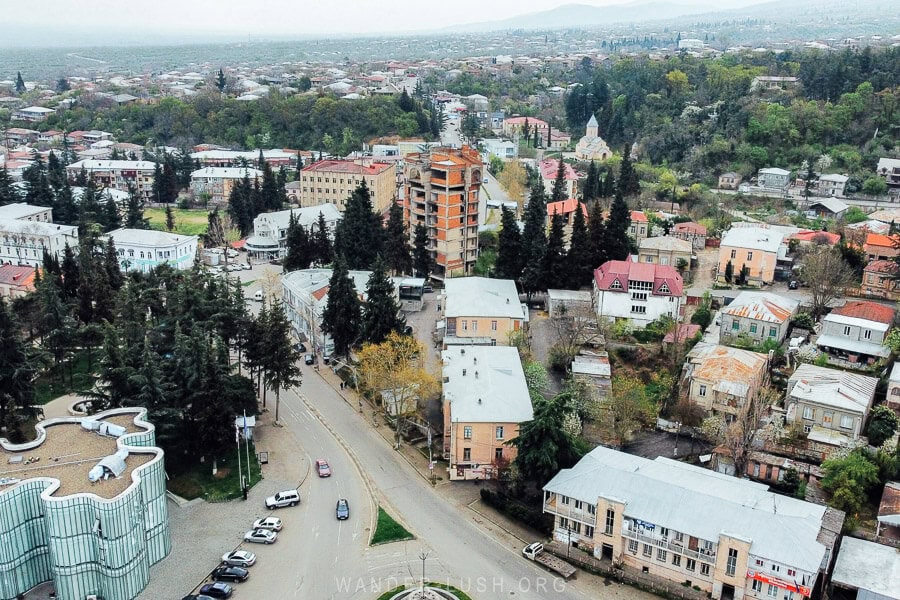
If you are visiting Kakheti, I want to convince you to spend some time in this overlooked corner of the wine region.
This travel guide covers things to do in Gurjaani town plus the villages of Bakurtsikhe, Chumlaki, Velistsikhe and Vazisubani.
Note: Visit Gurjaani and the City Hall of Gurjaani Municipality helped to coordinate part of my recent trip. I chose the locations to visit and paid for my own transport and accommodations. Some activities and meals were provided to me free of charge. All recommendations and opinions here are my own.
Please note: This post contains affiliate links, meaning I may earn a commission if you make a purchase by clicking a link (at no extra cost to you). Learn more.
When to visit Gurjaani
Autumn is the best time to visit Gurjaani and Kakheti in general, as the Rtveli sweeps through the Alazani Valley and visitors get a chance to observe and/or participate in the harvest ritual.
The Gurjaani Wine Festival, held annually around the middle of October, is a good milestone to plan your trip around. In 2023, it drew hundreds of exhibiting winemakers and more than 30,000 revellers, making it the biggest wine festival in Georgia.
Spring is the second-best time of year to visit this part of Georgia. As well as budding grape vines and new wines, Gurjaani is known for its peach orchards that come into bloom with shocking-pink flowers at the end of March.
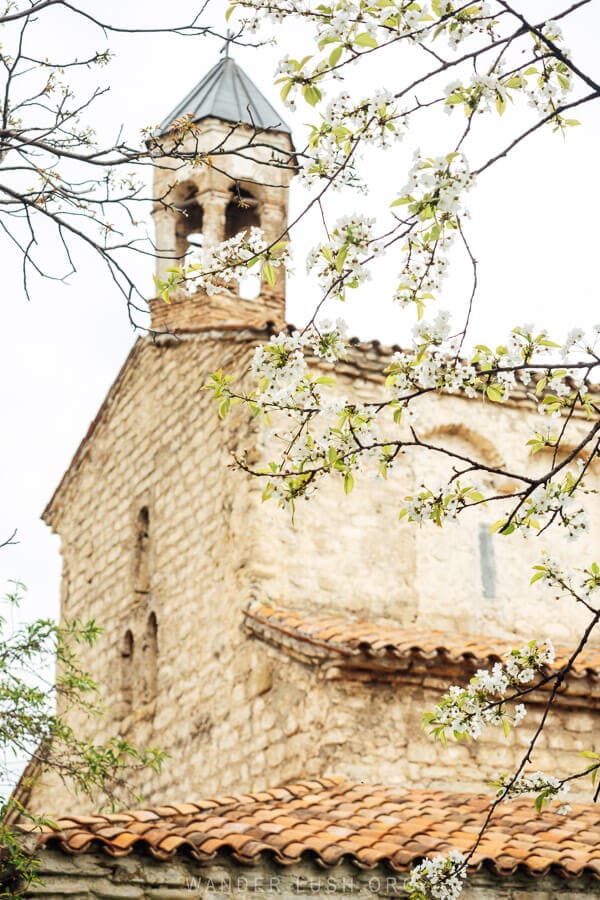
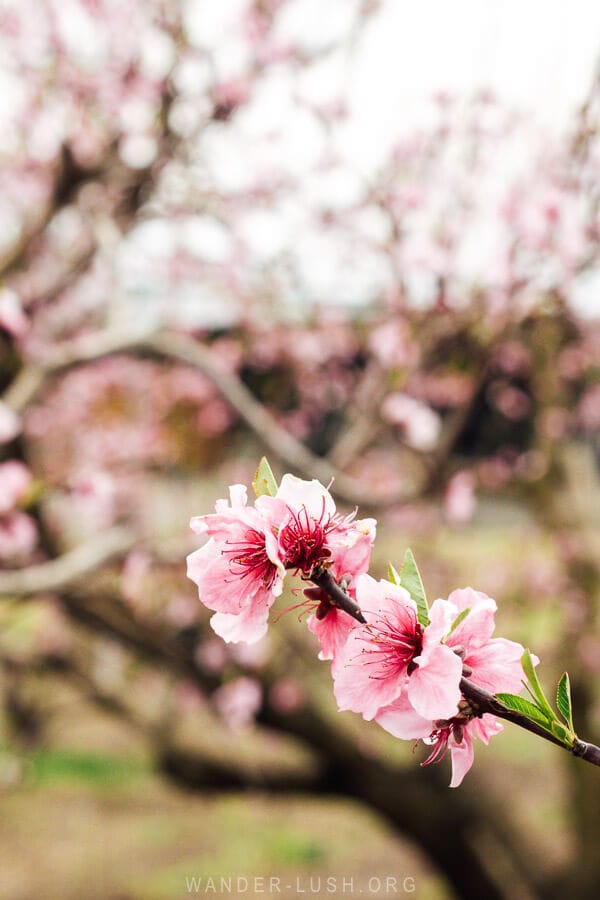
We visited Gurjaani in the second week of April and caught the end of the blossom season (see #10 below). Spring can be a little cloudy and rainy, but temperatures are pleasant.
Where to stay in Gurjaani
Because it is halfway between Telavi and Sighnaghi (with easy access to the other side of the Alazani Valley via the Kvareli-Mukuzani Road), Gurjaani is an ideal base from which to explore all of Kakheti.
We stayed at two different accommodations in Gurjaani: Horizons of Bakurtsikhe, who kindly hosted us for two nights, and Vazisubani Estate.
Horizons of Bakurtsikhe is a new cabin accommodation at the Tbilisi-end of Gurjaani, around 90 minutes by road from Tbilisi via the Kakheti Highway. Rooms are modern, with underfloor heating and electric blinds, and there is a pool and garden that overlooks a panorama of the Greater Caucasus. The highlight is the barrel sauna.
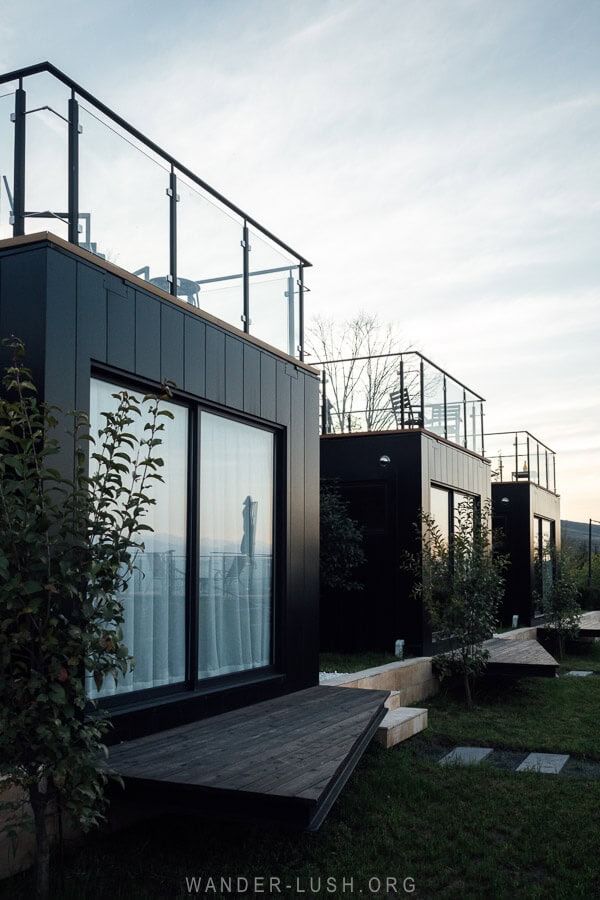
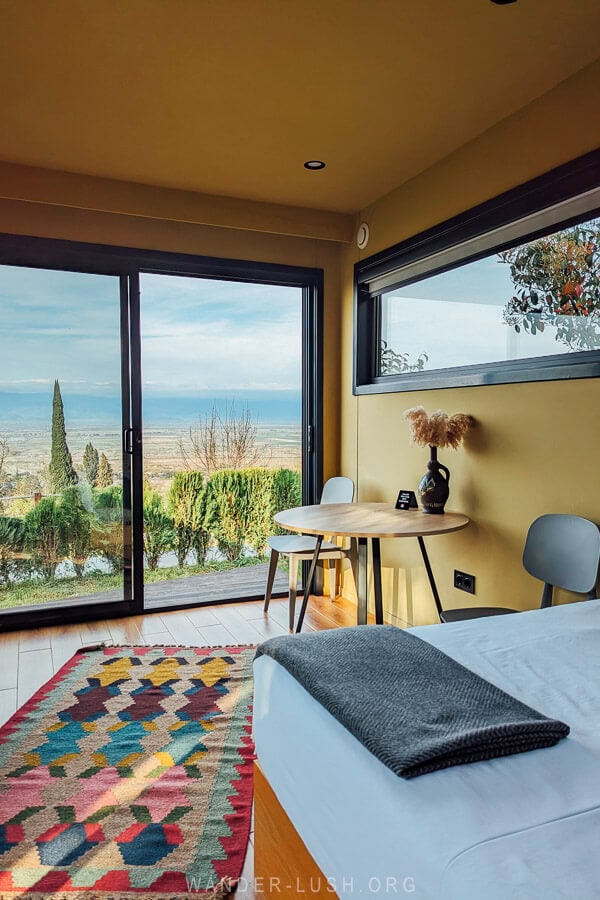
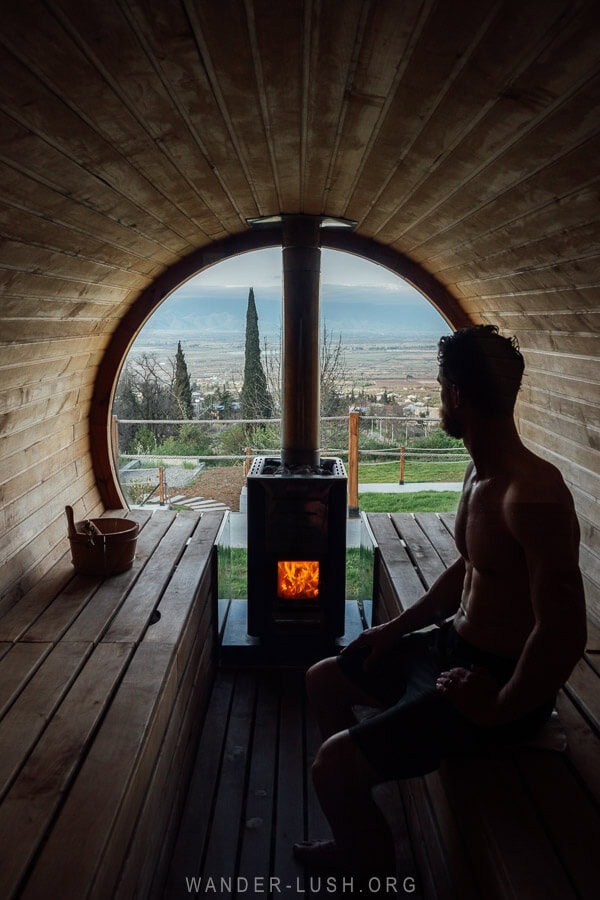
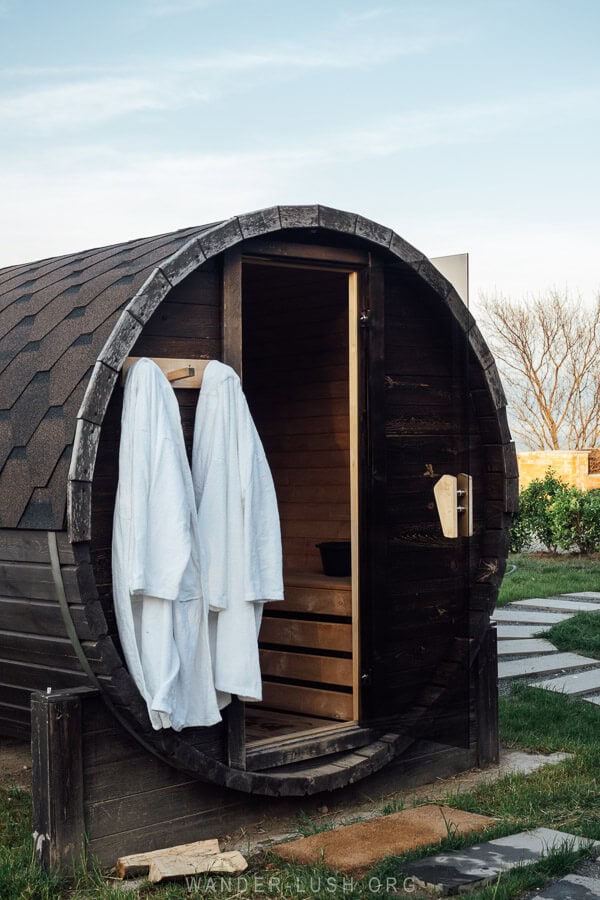
Vazisubani Estate is an established hotel located deeper in the valley, closer to Telavi. Elegant rooms are set inside a restored 19th-century palace, while the hotel’s restaurant and pool have a contemporary design (again with a perfect panorama of the mountains).
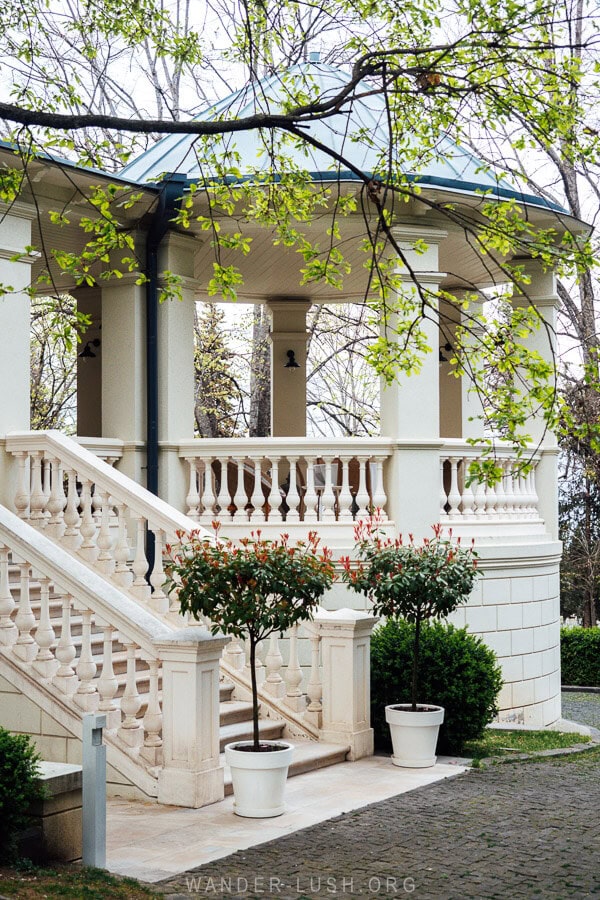
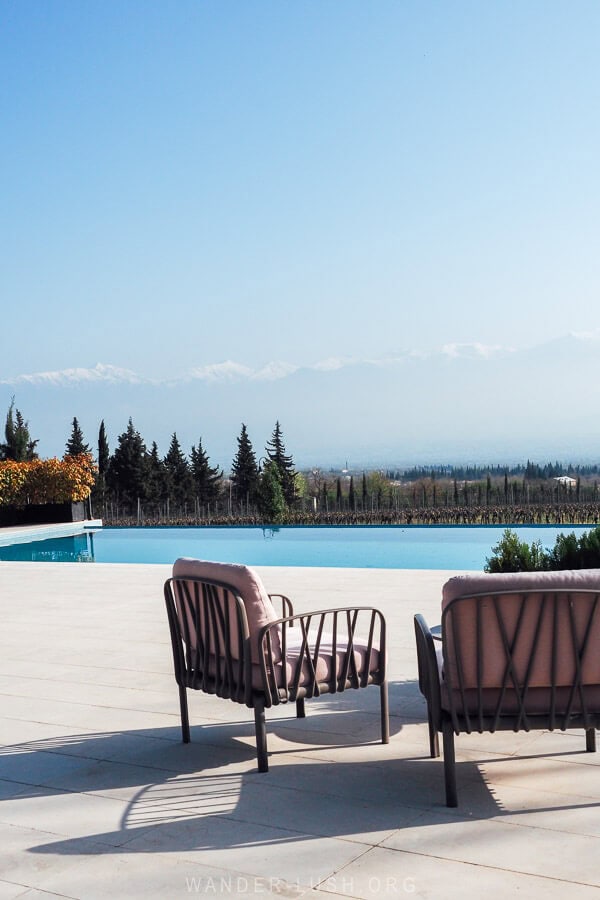
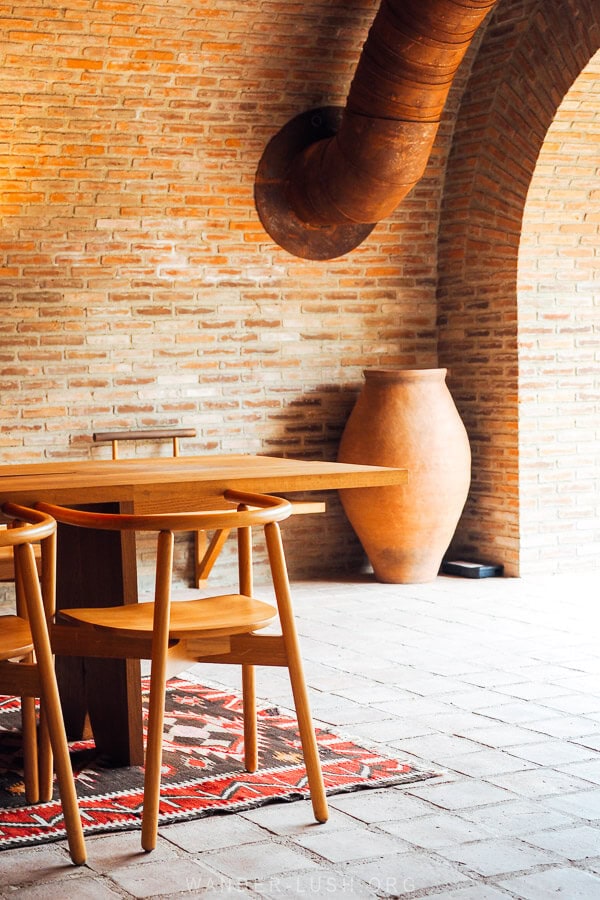
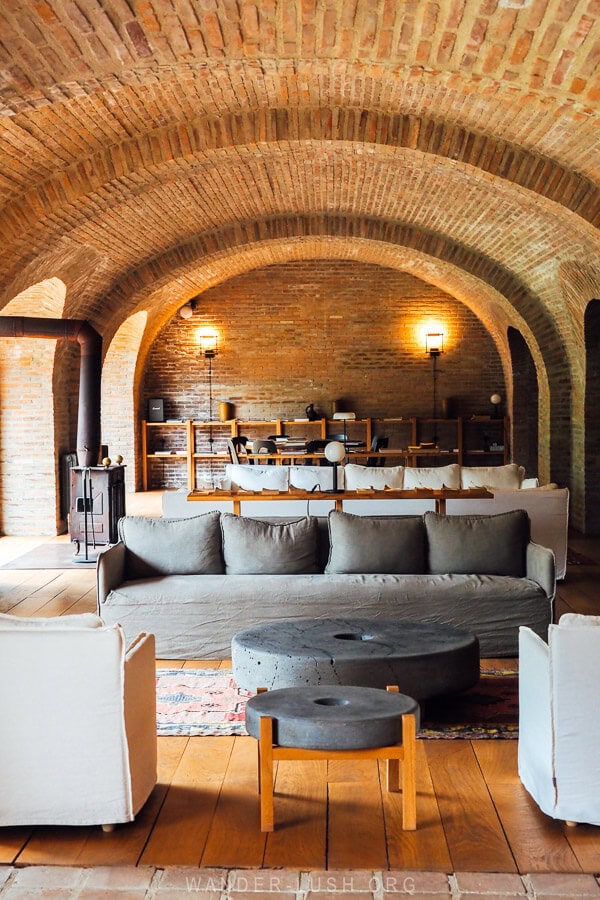
Two more reputable accommodations in Gurjaani are Chateau Zegaani, a restored house from 1820 set on a vineyard, and Ampelo Resort, a contemporary complex that is perfect for families or for an all-inclusive vacation.
How to get around
While Gurjaani can be reached by marshrutka van from Tbilisi, once you are there, you really need your own transportation to get around. The attractions covered in this short guide are spread out across the municipality and relying on public transport would make things quite challenging.
Plus, there are so many interesting monuments and buildings to stop for along the road.
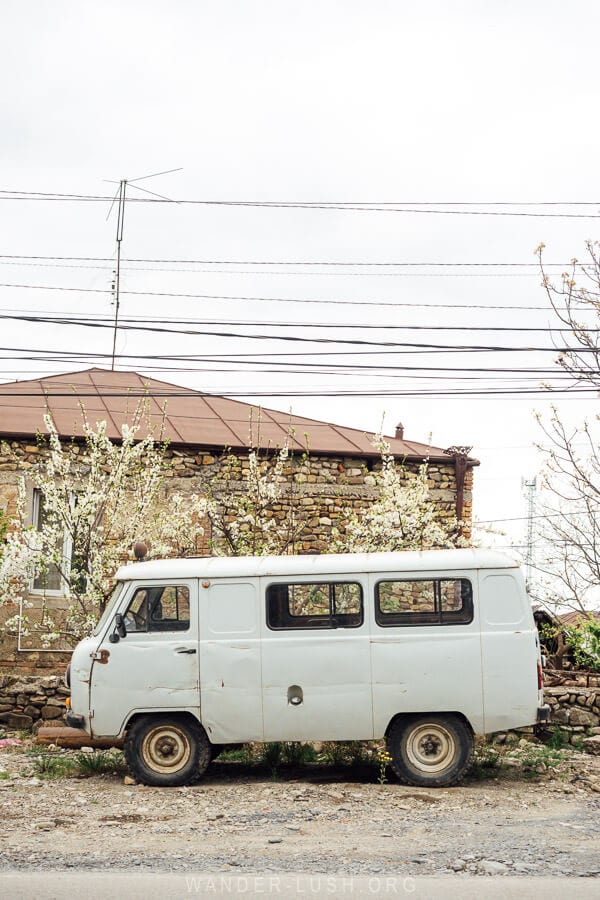
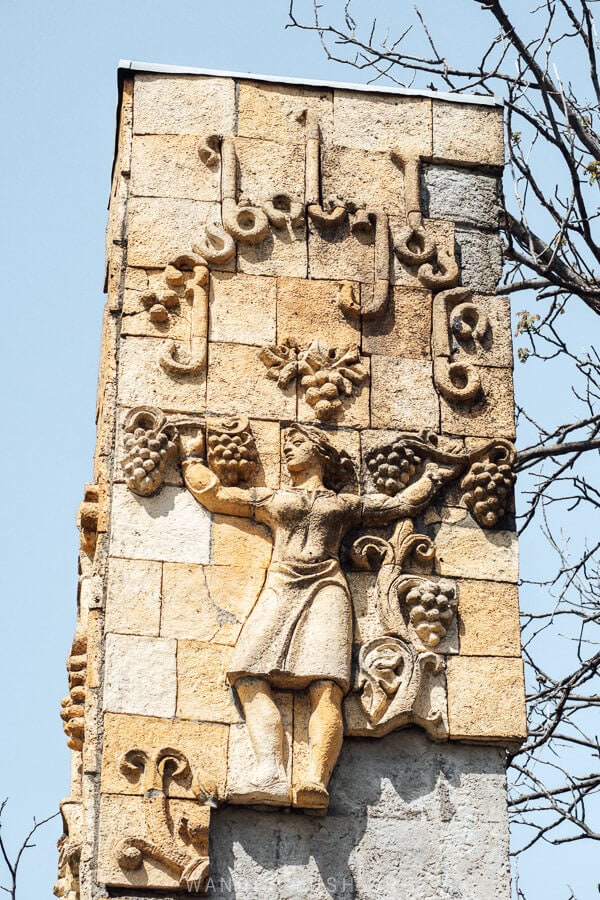
I recommend either organising a private car and driver through GoTrip, or ideally renting your own car. We hired a car from Local Rent for our trip.
See this guide for more transport details on getting to Kakheti from Tbilisi.
10 things to do in Gurjaani
1. Do a wine tasting
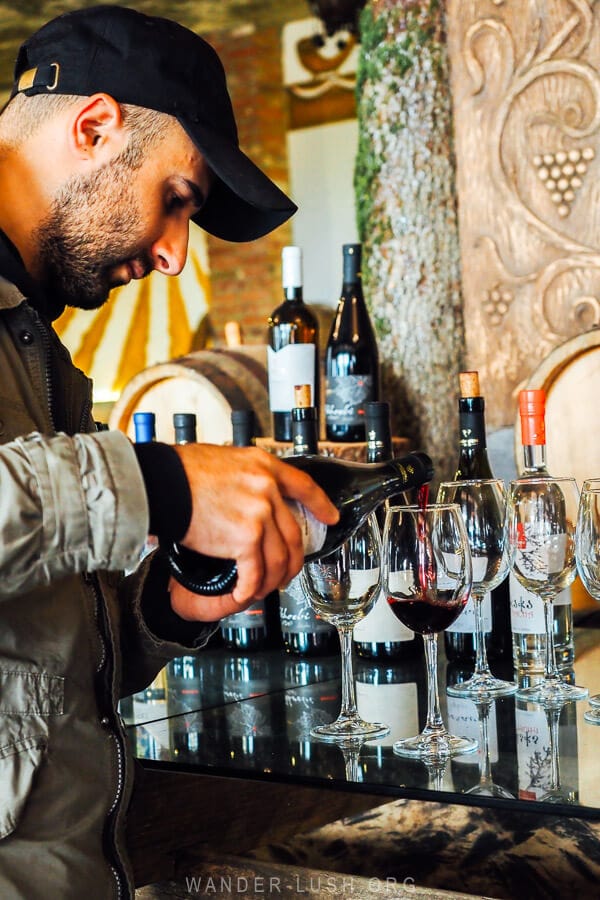
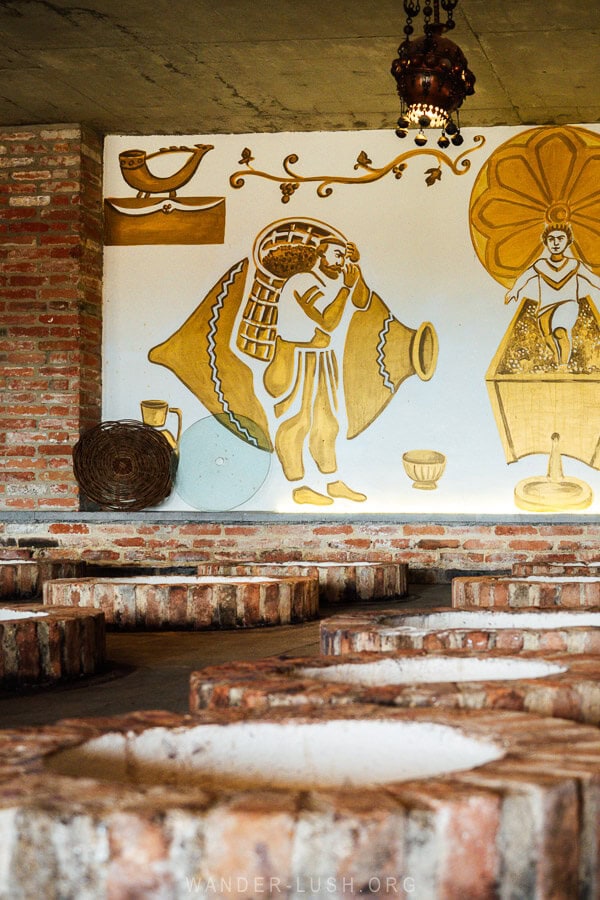
With two out of three families involved in winemaking, vino is big business in Gurjaani. Some of Kakheti’s most iconic wineries are located in this municipality, which has no fewer than six PDOs (Protected Designation of Origin) for a variety of grapes including Rkatsiteli, Saperavi, Khikhvi and Mtsvane.
We did a wine degustation at Kardanakhi1888 (Ampelo), a winery, restaurant and resort set in Kardanakhi on some of the company’s 16 hectares of vineyards. The cellar is beautifully decorated with murals and a showcase of qvevri and European-style winemaking methods. I especially like their dry white Mtsvane-Khikhvi from the Akhoebi PDO.
We also had a terrific meal at the restaurant here.
Vakho Oqruashvili Wine Cellar is a smaller family owned and operated winery in the historic town of Velistsikhe. I first came here several years ago on a wine tour from Tbilisi and have stayed in touch with the owners over the years. Vakho and his family are amazing hosts!
If you want to learn about Georgian’s UNESCO-listed qvevri technology and potentially taste new wine direct from the source, this winery is an excellent choice.
Other notable wineries in Gurjaani municipality include Berika’s Winery and Velistsikhe Veranda Wine Cellar (Velistsikhe), Givi’s Wine Cellar (Mukuzani), and Vardiashvili Family Wine (Vazisubani). All of these small cellar doors are open to visitors, offering a combination of tours, degustations and sit-down meals. Advance bookings are essential.
Chateau Zegaani and Vazisubani Estate both produce their own wines, too.
2. Tour the biggest winery in Georgia
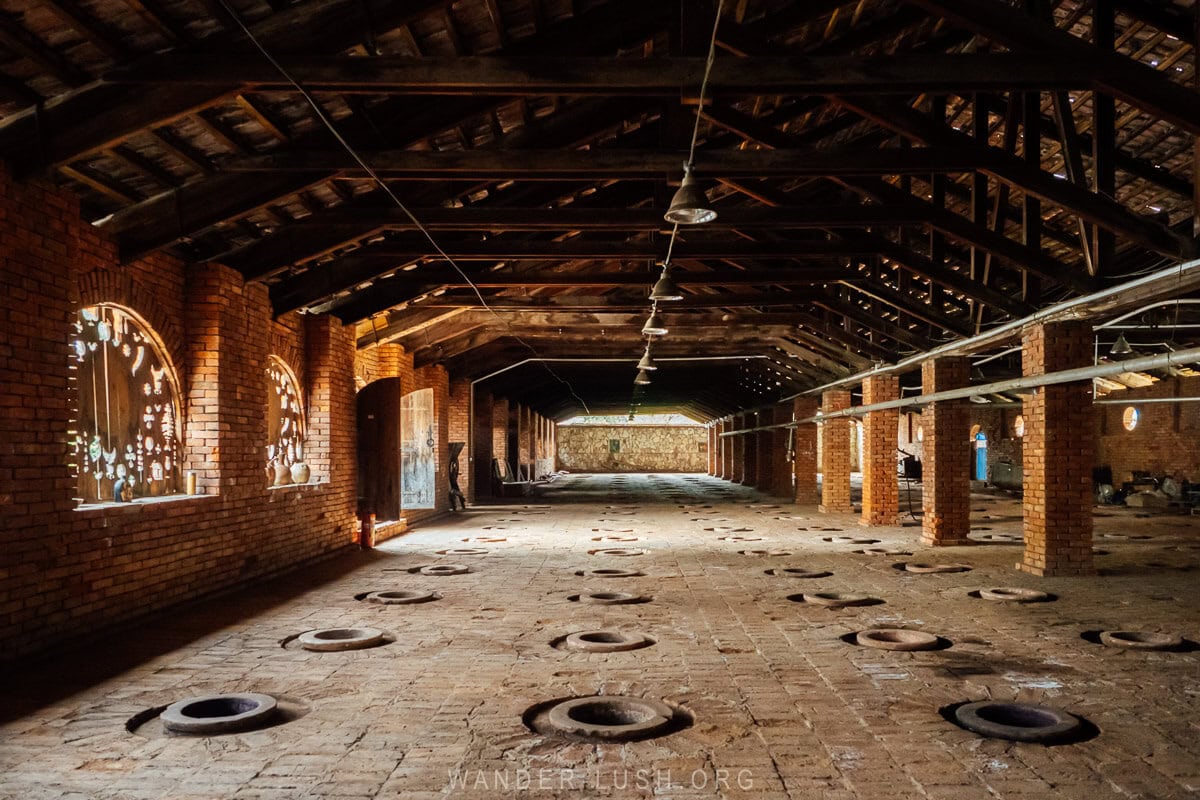
Established in 1929, Bolero is the biggest and likely the oldest commercial winery in Georgia. This massive factory on the outskirts of Gurjaani town produces an eye-watering 100 million litres of wine every year.
The winery is not normally open to visitors, so I was very lucky to tour Bolero’s wine-making facilities and massive underground Spirit Reserve. The grounds – which include a dedicated railway station! – are littered with Soviet-era architecture and monuments.
Established under communism, it was originally known as the ‘Red Cellar’. The original marani – filled with clay qvevri that were confiscated from winemakers as part of the effort to collectivise and industrialise winemaking – represents a fascinating and very sobering chapter of Georgian history.
At the time of writing, Bolero is still closed to the public, but there are plans in the works to establish a museum here and open the gates to visitors. I will return to update this when details become available.
In the meantime, you can hopefully get a sense for the scale and history of this place by reading my full account of visiting Georgia’s biggest winery.
3. Visit a few of Gurjaani’s most important monasteries
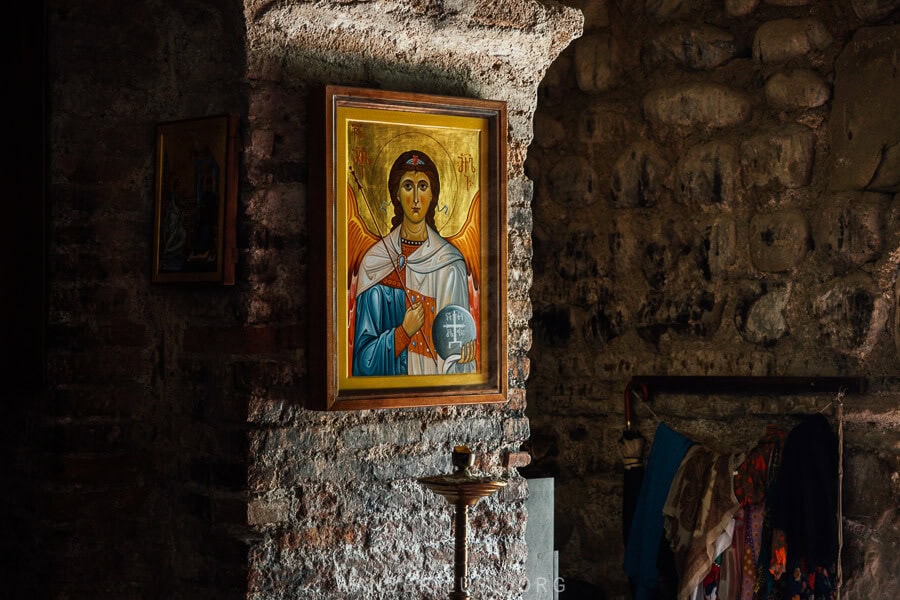
As is typical of Kakheti, Gurjaani is also known for its Orthodox monasteries and churches that are peppered amongst the vineyards, hidden away in small villages and perched on remote hills.
There are three that I recommend prioritising.
Gurjaani Kvelatsminda (8th-9th century) is the symbol of the municipality and is widely considered to be one of the most important and sacred monasteries in the country. Its design – which features two domes – is unparalleled in Georgia.
The short walk from the road down to the monastery via a forested path is exceptionally peaceful and pretty, especially in spring when the entire way is shrouded in new shoots. It’s difficult to appreciate the double-dome design from inside, but it’s still worth ducking in to see the frescoes. At the rear of the church there are a couple of wooden balconies set into the wall, accessible from a second door on the side of the building.
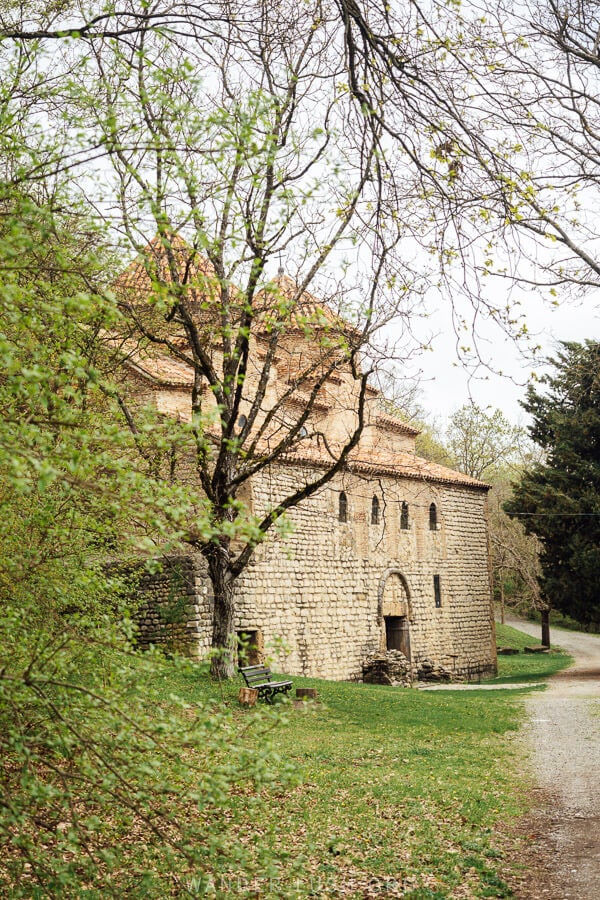
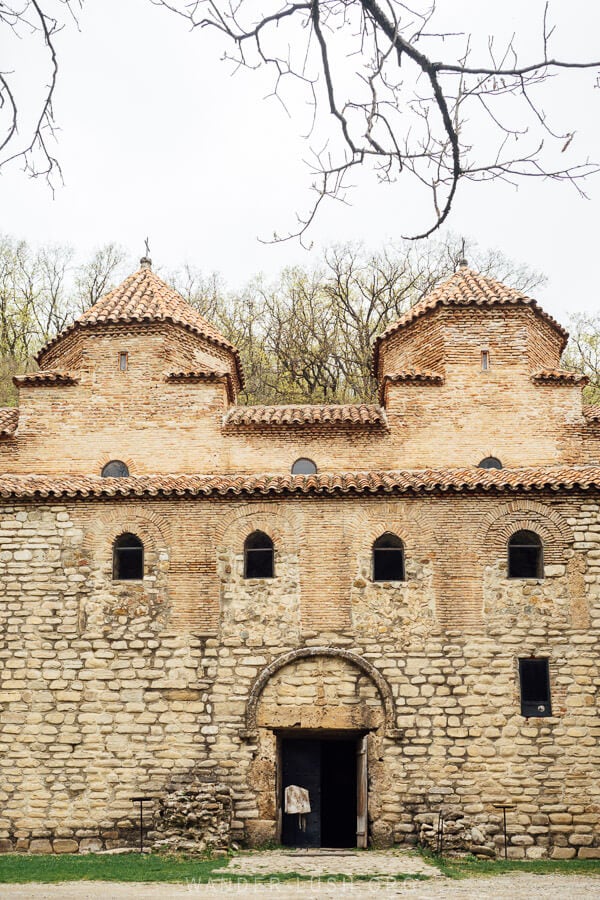
When Kakheti was under siege from Shah Abbas in the 17th century, one of the Church’s most important icons, the Mother Ivera, was brought here for safekeeping. Today Kvelatsminda remains an active monastery with a community of monks living nearby. They keep a wine cellar and sell honey and other items at the small gift shop at the entrance.
Vejini Monastery (10th-11th centuries) is located on the same mountainside, 6 kilometres away from Kvelatsminda by road. Quite incredibly, the two are linked by an underground tunnel bored through the mountain range.
Vejini is a larger complex with a lower convent and an upper men’s monastery called Amagleba. The former has a gorgeous little garden (just like Bodbe near Sighnaghi, it definitely has a woman’s touch!), while the upper monastery complex also includes the ruins of Vejini Castle.
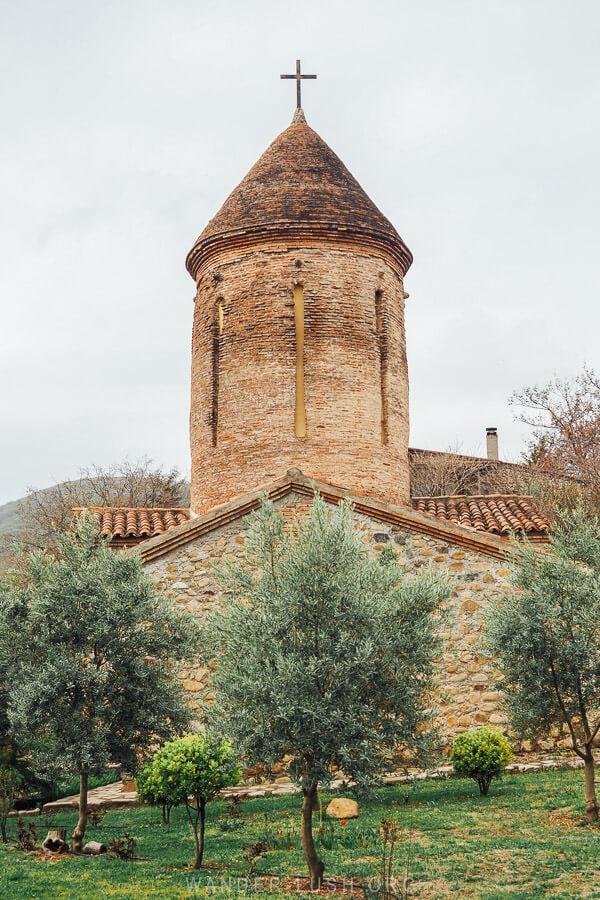
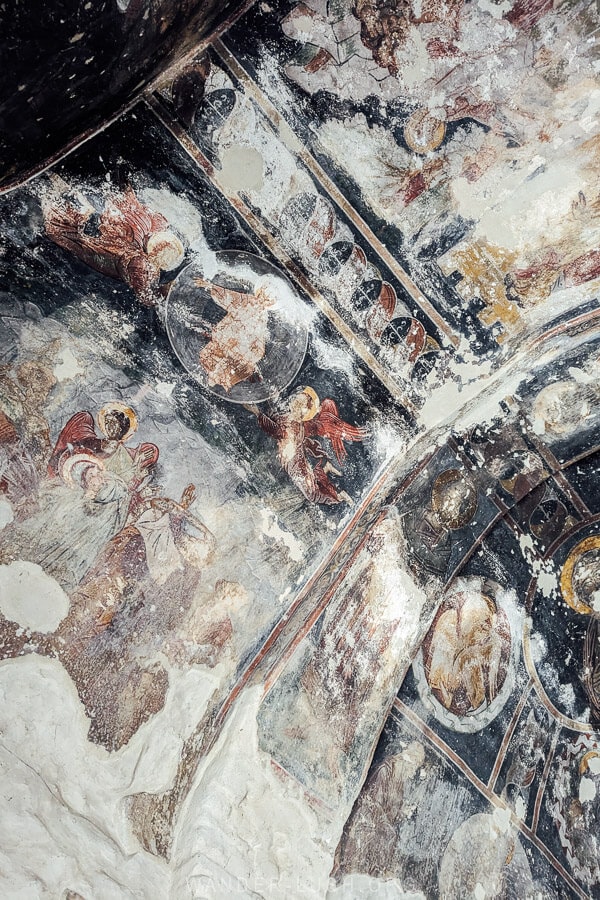
Looking across the valley from the convent grounds you can see an old stone watchtower.
Finally, I recommend visiting the Cathedral of the Assumption of the Virgin Mary or Gvtismshoblis Midzinebis Tadzari (6th century), located just off the highway in Vazisubani. This church is not as well known – we happened upon it almost by accident.
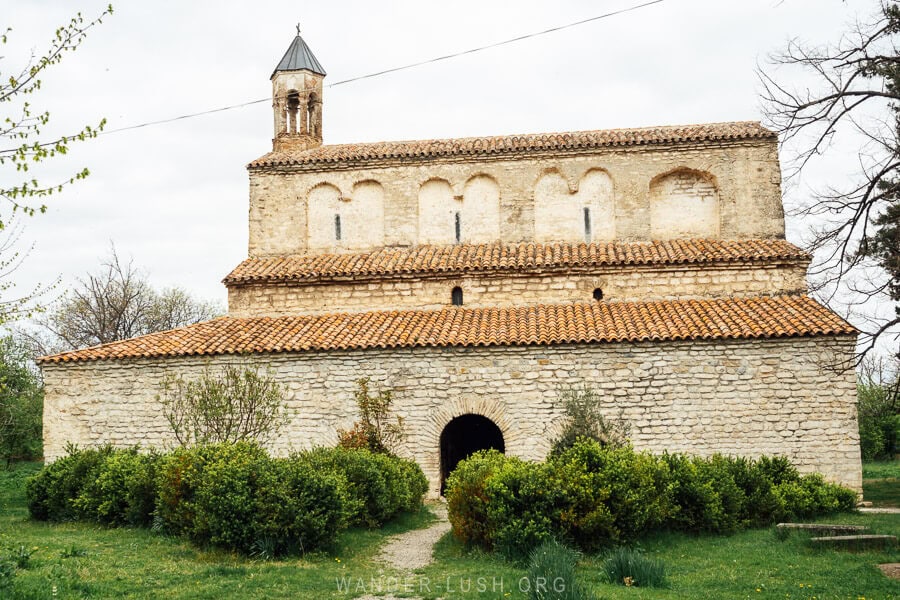
The three-nave basilica is constructed from cobblestones and has a long enclosed cloister on its bottom level, inside which you can see a miniature replica of the building. The design reminds me a lot of the churches we visited in Albania, especially St Mary’s in Leus.
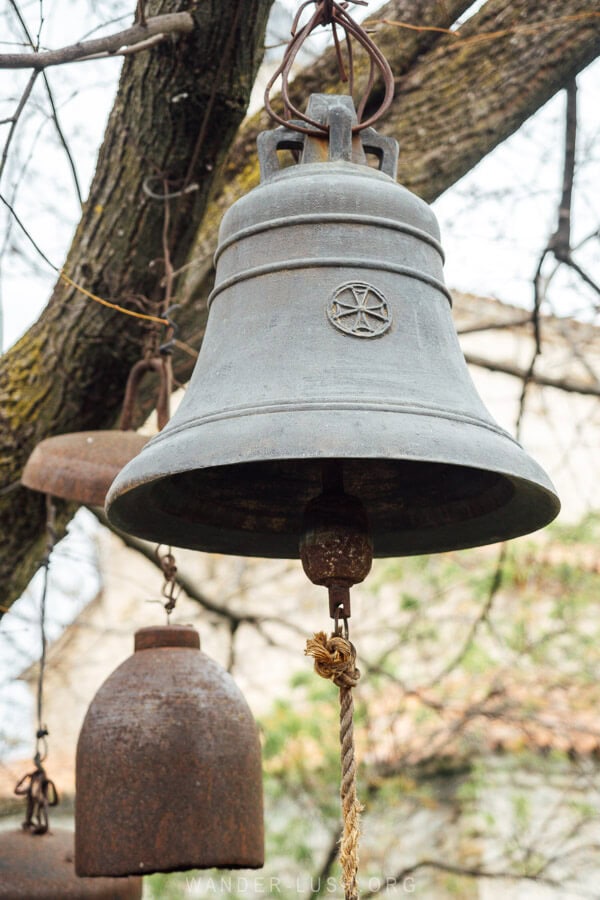
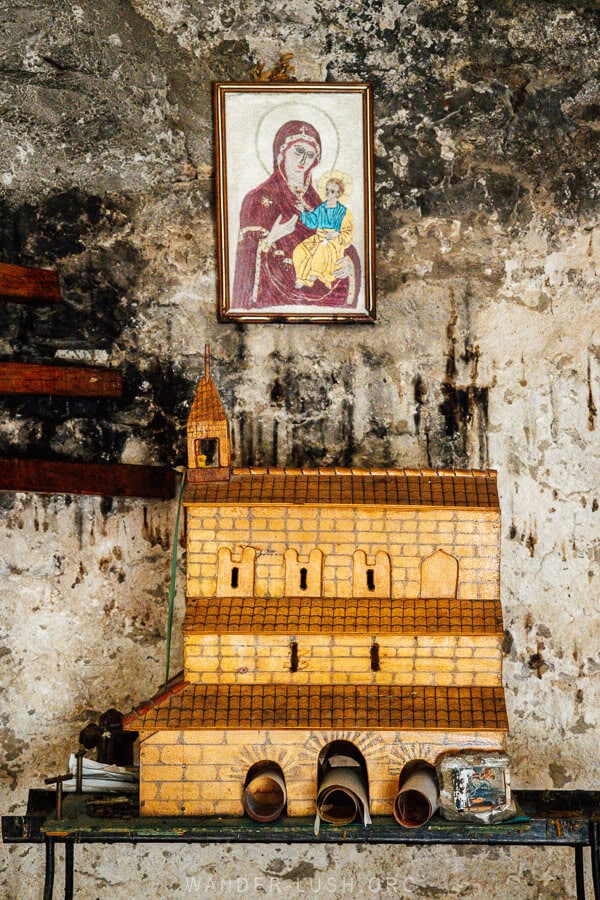
Unfortunately the doors were locked (from the number of icons and votive candles placed outside, I’m guessing this is the norm), but it is still very much worth stopping for a look at the facade and surrounding grounds, which feature a water well and a number of old gravestones.
4. Explore Soviet architecture & memorials in Gurjaani town
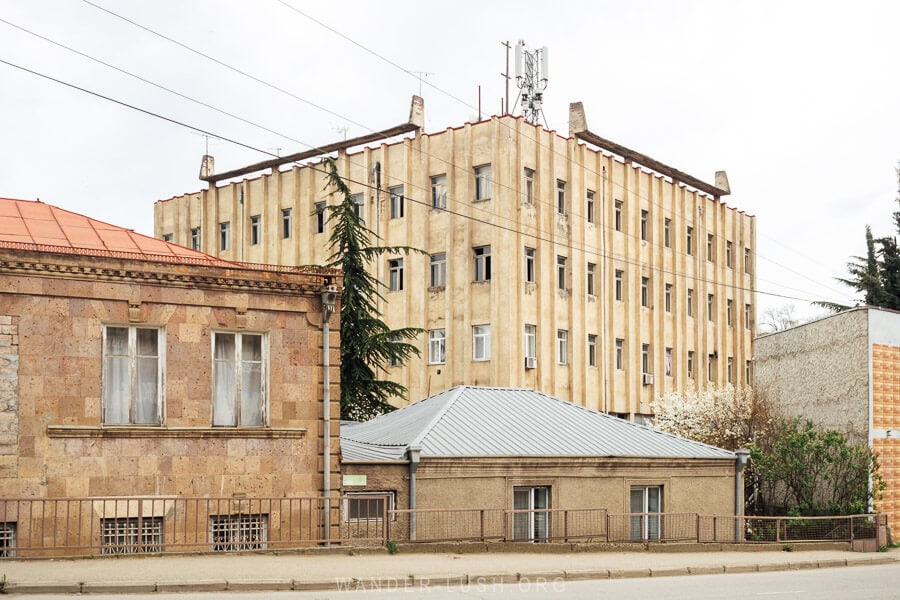
One of the main reasons I wanted to spend time in Gurjaani was to check out the town’s Soviet-era architecture. If you share my penchant for relics from this period of history, you will find Gurjaani quite a treat.
Much like Rustavi near Tbilisi or Zestafoni in Western Georgia, Gurjaani is a ‘new’ city that was purpose-built during the Soviet era. Its history as a settlement goes back much further – in this case to the 16th century – but the majority of the buildings and infrastructure we see today dates to the 1930s and 1940s.
Created for the workers of Gurjaani’s wine, canning and brick-making factories and their families, the town features dozens of identical four-storey apartment blocks, schools, a library, and other civic services – including one of the most impressive Culture Houses I have ever seen.
Here are the main points of interest in Gurjaani town.
Built when the Kakheti railway was constructed in 1915, Gurjaani Train Station (below left) is (or was) the epicentre of the town. There are no more passenger trains in Kakheti, but the station still sees freight services pass through. The station building – lemon-coloured and with a typical design of columns and arches – is still in use.
The recently refurbished Gurjaani Library (below right) has a similar colour scheme and an impressive corner facade. We popped inside the library for a look around and were treated to a 30-minute tour of the reading rooms and archives. Staff are incredibly friendly!
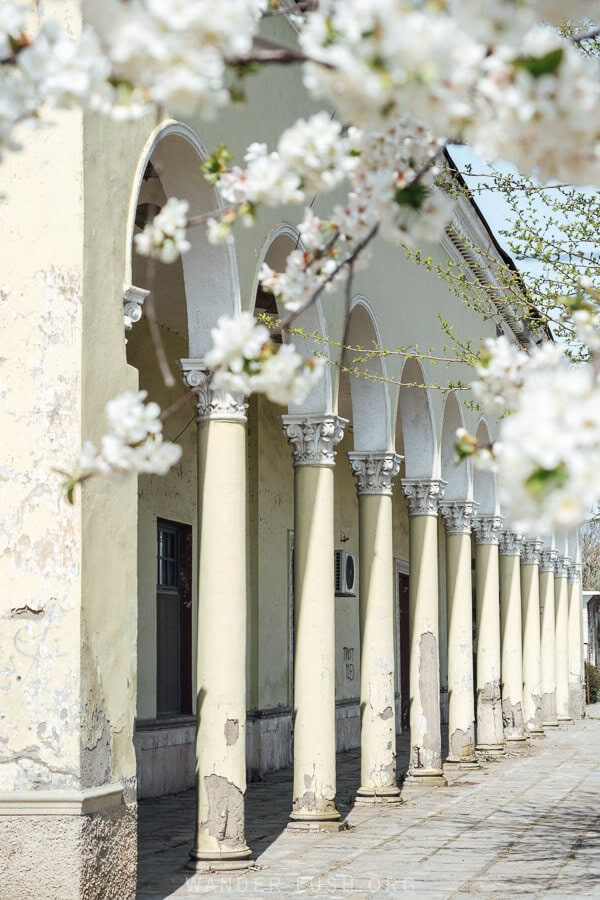
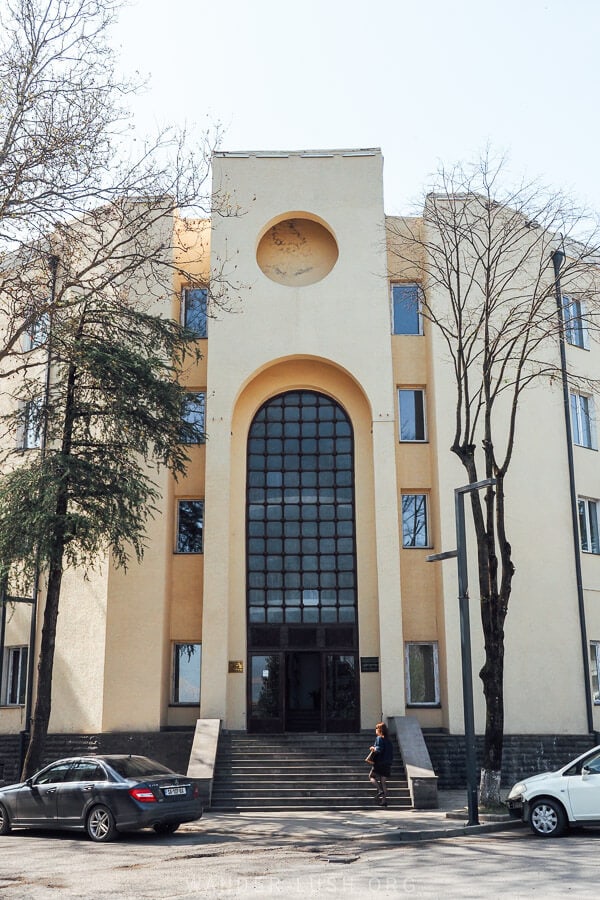
From the library, you can walk up Ioseb Noneshvili Street (named for the Kardenakhi-born poet) to see a range of other Soviet-era buildings, many of which have been refurbished. The Music School (below left) has an interesting metalwork decoration on its facade.
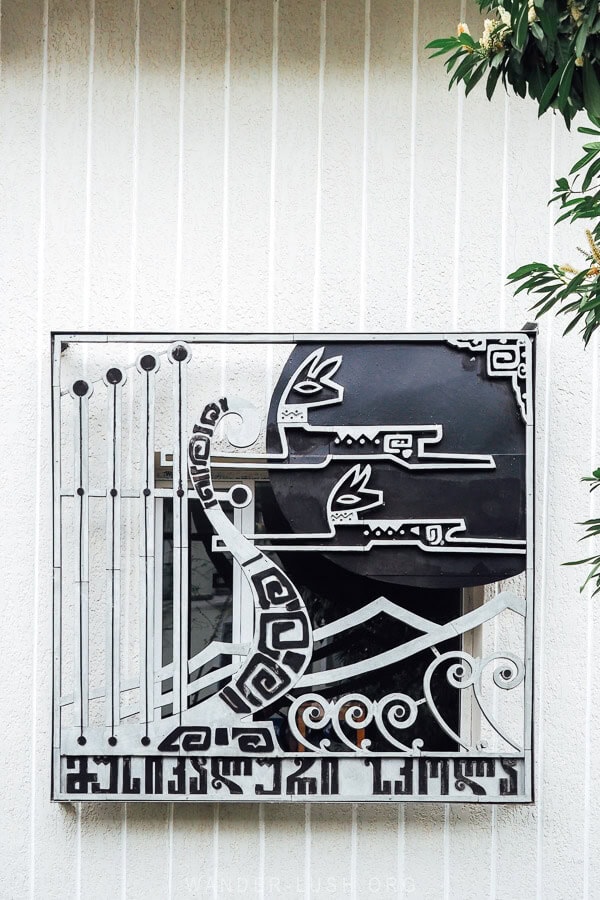
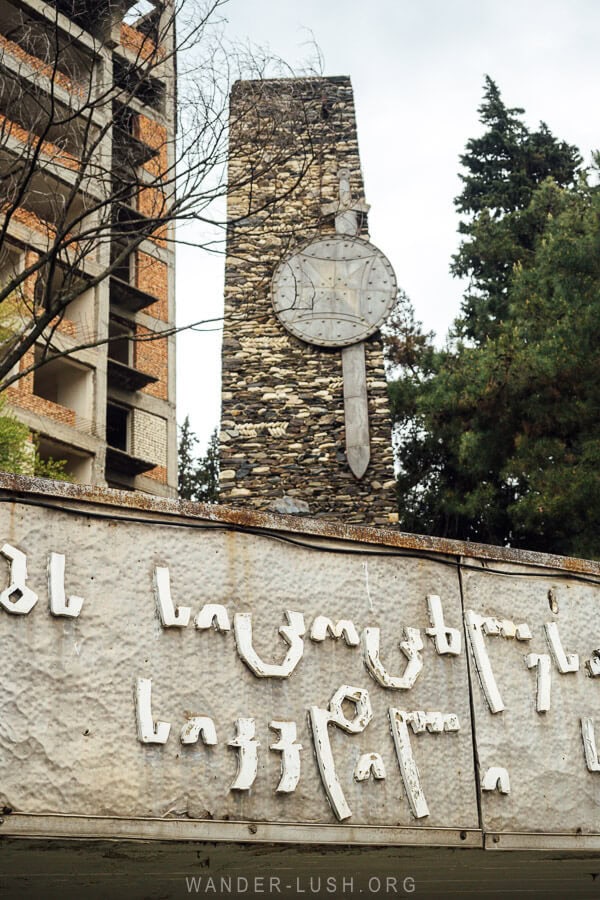
At the top of the street, you will see a small park and War Memorial (above right) with several sculptural components and Soviet-style reliefs. Papa’s Baghi or Grandfather Garden is a green square with a cool sculpture at the entrance.
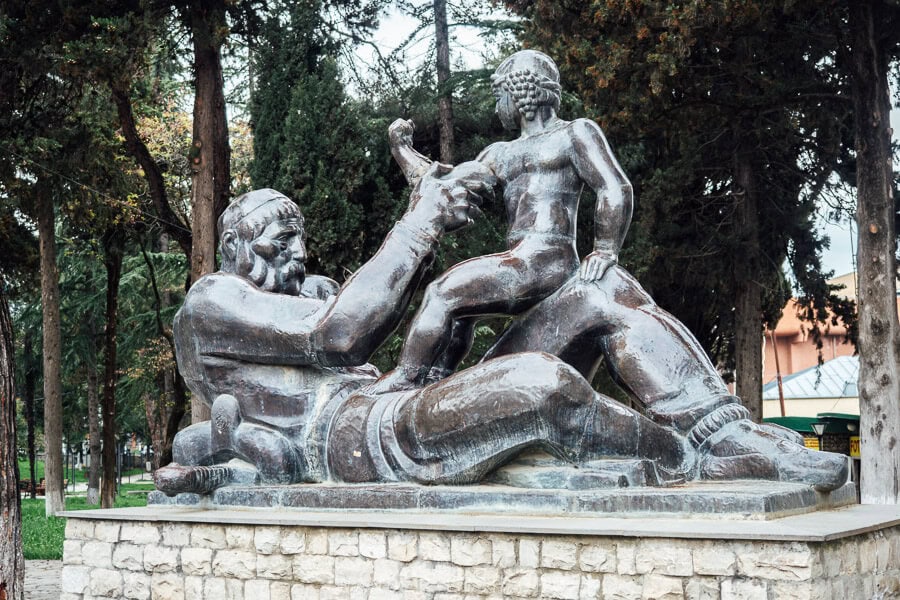
The park backs onto the massive Gurjaani Cultural Centre, which was originally constructed as a Soviet Palace of Culture. The north-facing facade is mounted with a five-piece metal sculpture of the muses.
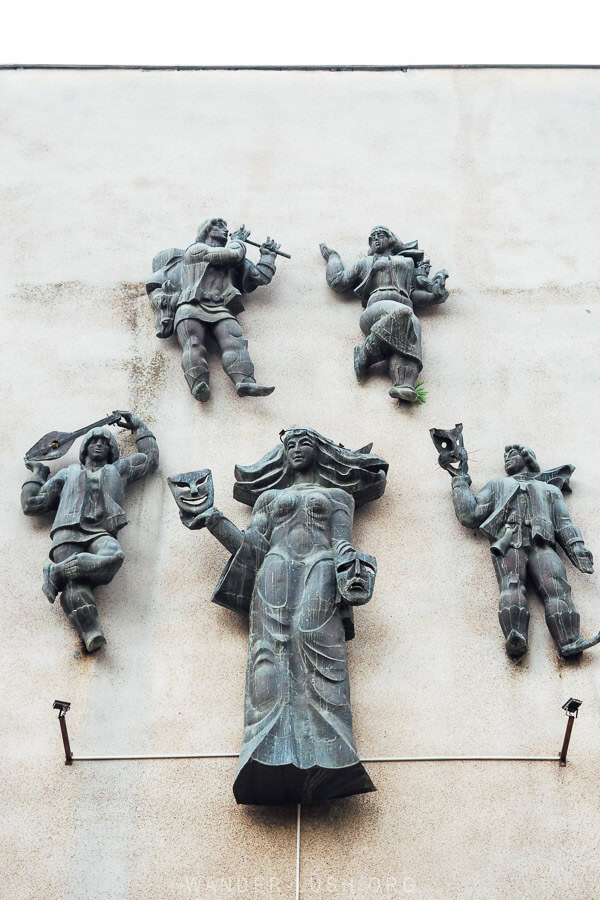
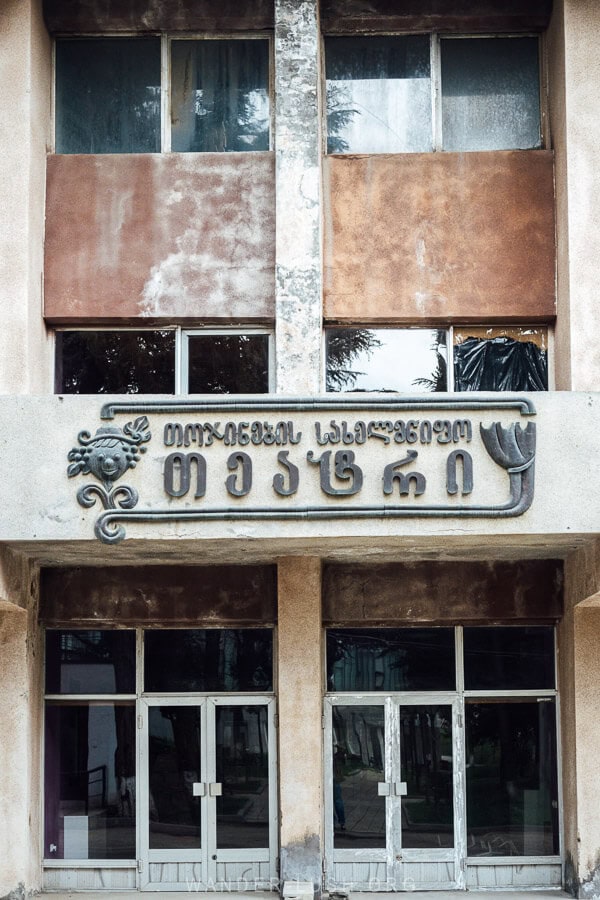
Inside, the building contains different theatres including a children’s puppet theatre. We found the door open and walked in for a quick look around – even the stairwells and landing areas are impressive, with parquet floors, sculptural wooden balustrades and epic canvases hanging on the walls.
Staff were happy for us to wander through.
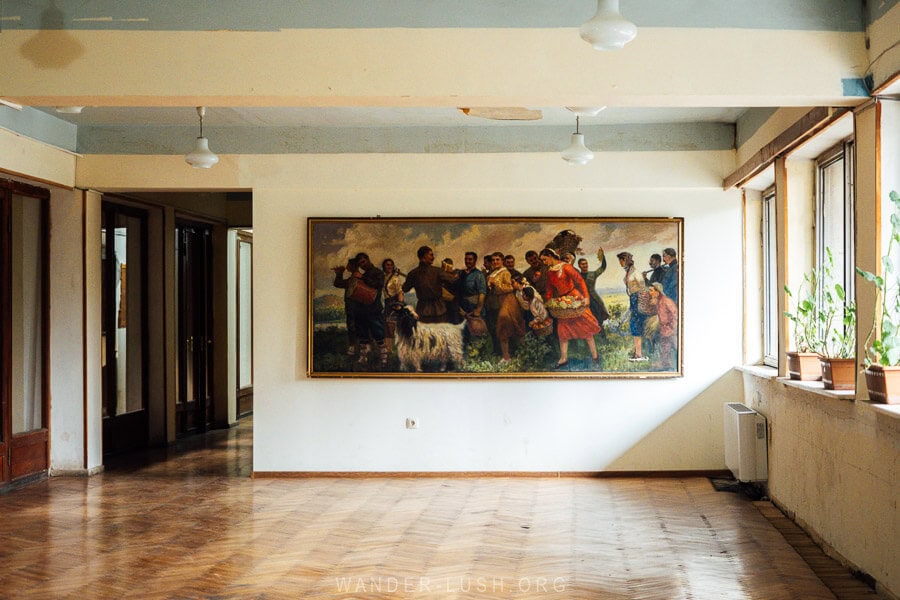
Further down the road, Gurjaani’s Holy Trinity Church was constructed in 2012. Next door, there is an interesting single-storey building decorated with three relief sculptures that depict qvevri wine making and characters from the old Georgian alphabet. I’m told that it used to be a museum, but it is now used by the church.
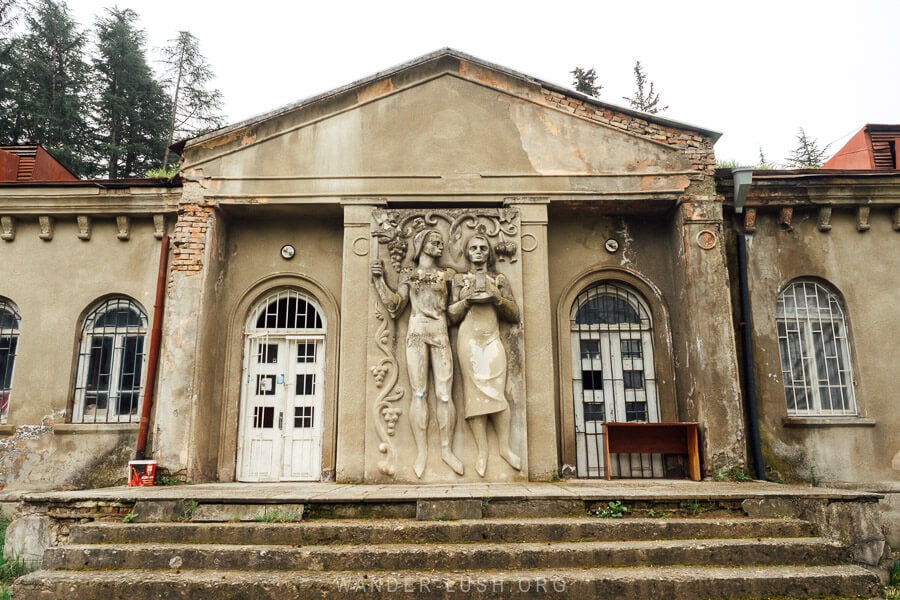
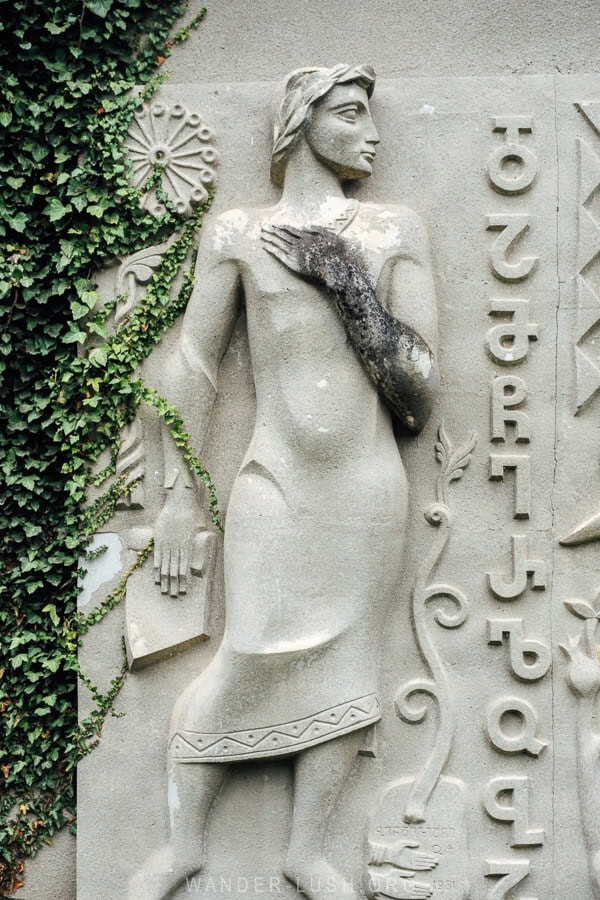
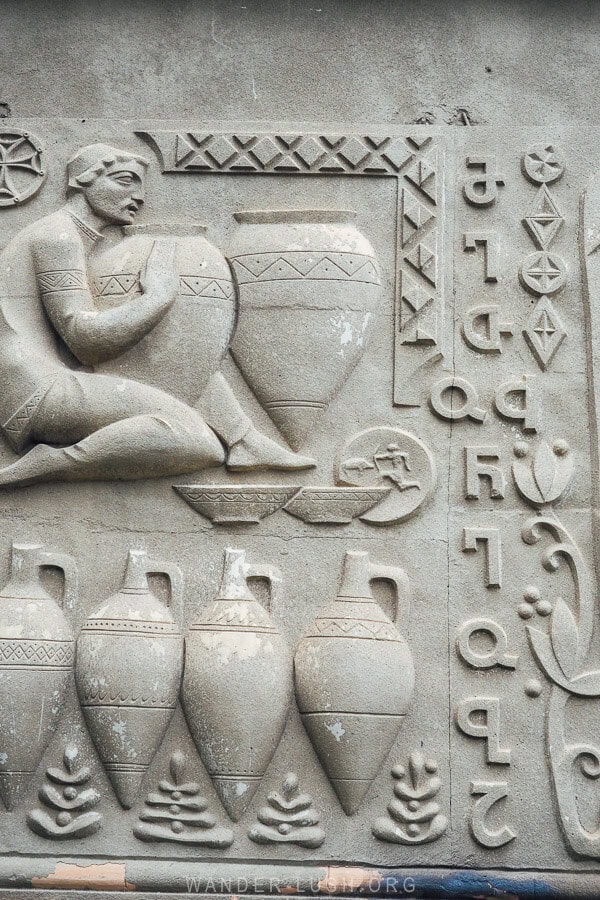
Finally, the Gurjaani Bazari is located on the street in front of the church, alongside the Akhtaliskhevi River, and is worth a quick wander. It is a modern covered agrarian market with fresh produce stalls and a lively butcher’s section.
If this sort of thing interests you, then I also recommend visiting the Vazisubani Palace of Culture 20 minutes’ north of Gurjaani town. Established in the 1950s, it is another example of a once-grand theatre and arts centre that has seen better days, but still remains open and is very much valued by the local community.
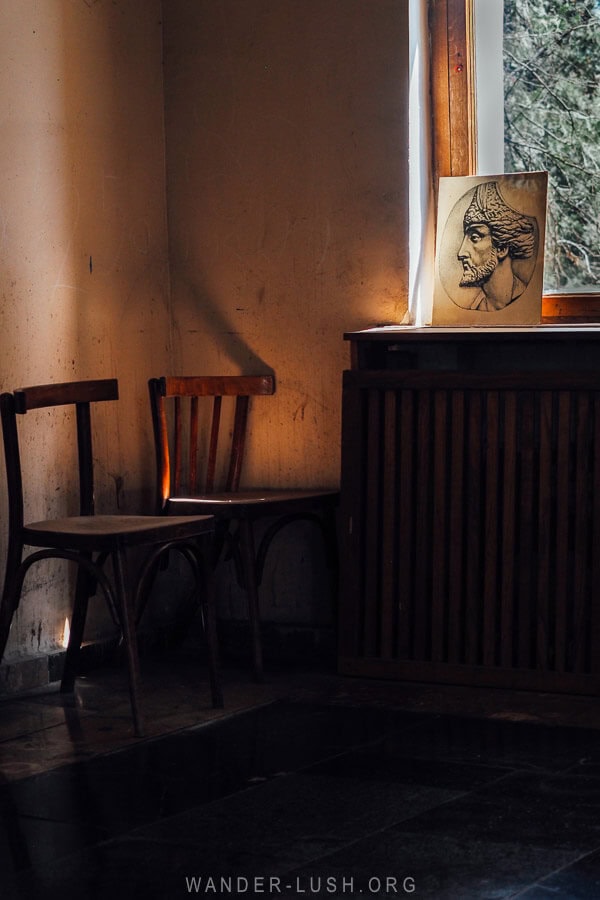
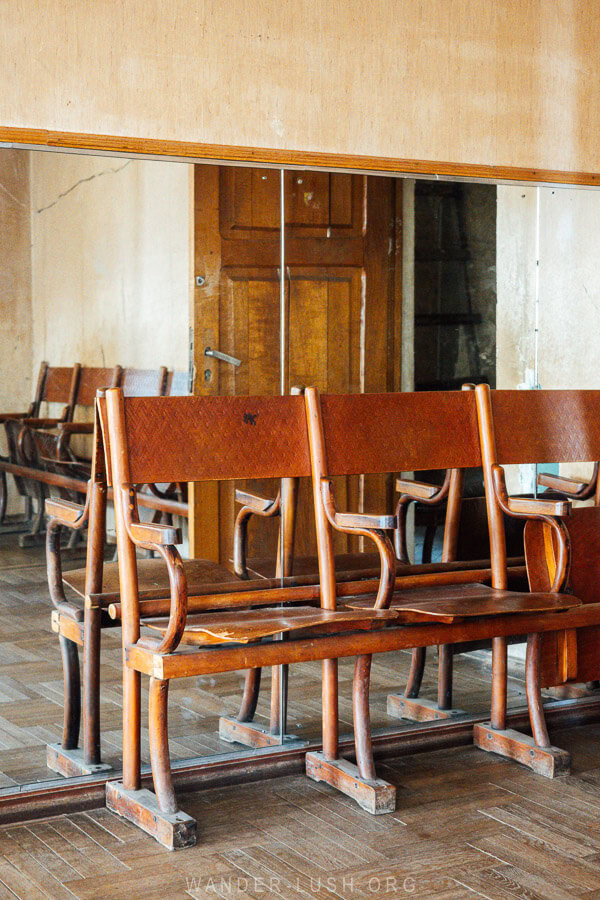
It’s always a bit of a gamble as to whether or not you will be able to access such buildings. I had assumed this Culture House might be abandoned, but we arrived to find half a dozen women working inside. They very generously showed us around the building, turning on the lights so we could see the theatre’s red velvet chairs and stage. Upstairs there are several dance studios that are still in use.
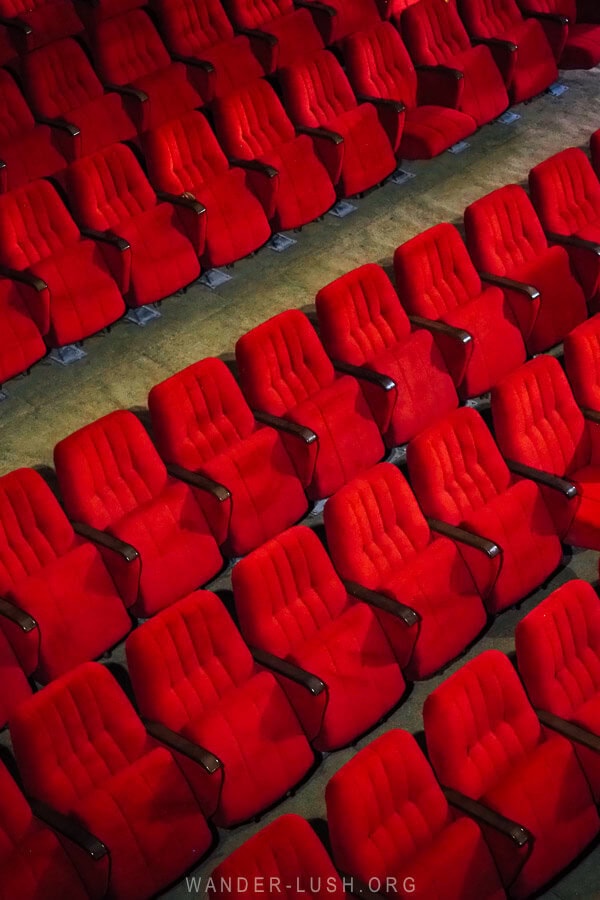
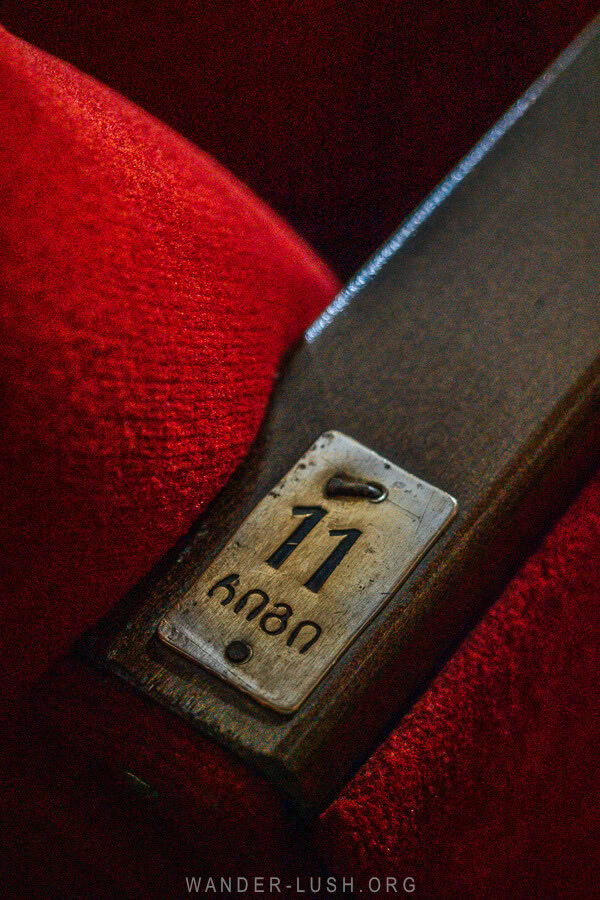
The sheer size of this place relative to the village of Vazisubani itself shows you just how much the population shrunk after the fall of the USSR. It is a similar story with villages in Guria and Western Georgia, once centres of agriculture (in this case for tea and citrus rather than grapes) but now just a shadow of their former selves.
5. Admire the former bus station mosaic
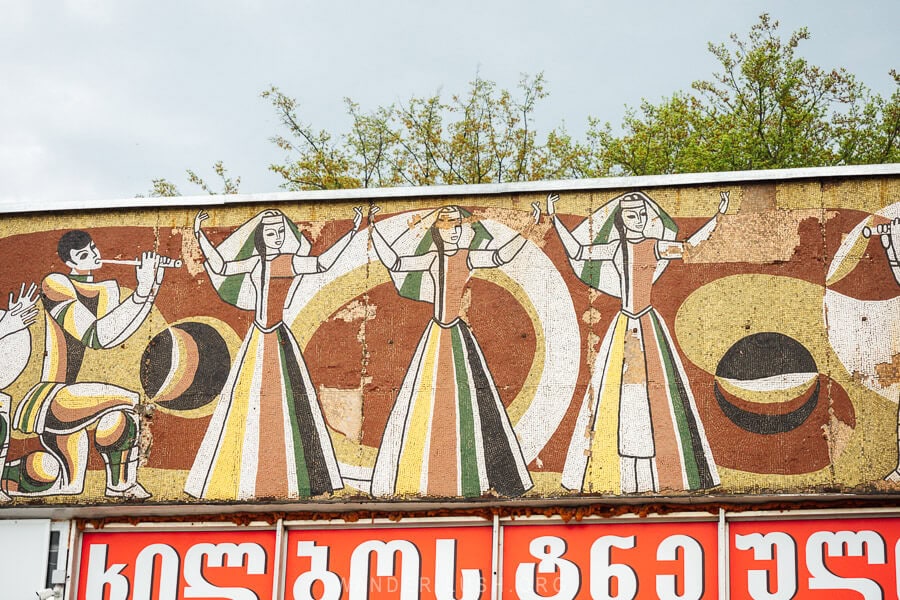
If you have driven through Gurjaani, you would have no doubt noticed this large-scale mosaic at the roundabout adjacent to Papa’s Baghi. Created in 1985 by artists Leonardo Shengelia and Enriko Kopadze, it is a vast panno that wraps around the entire service complex.
The main street-facing panel has an earthy brown-and-green colour scheme. It depicts different stages of the grape harvest along with folk music and dance. I love the arrangement of female dancers and salamuri players along the shorter wall – each character has different features and a unique facial expression.
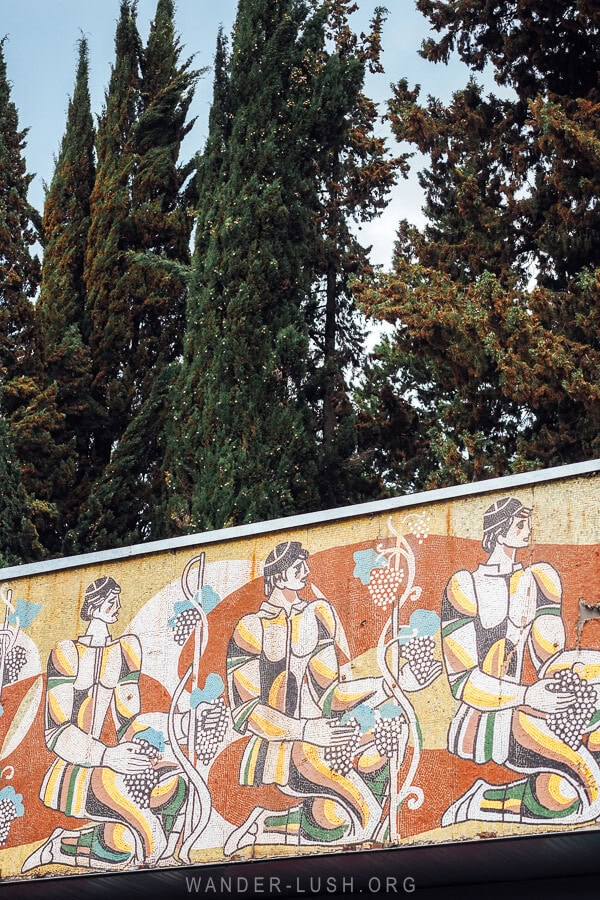
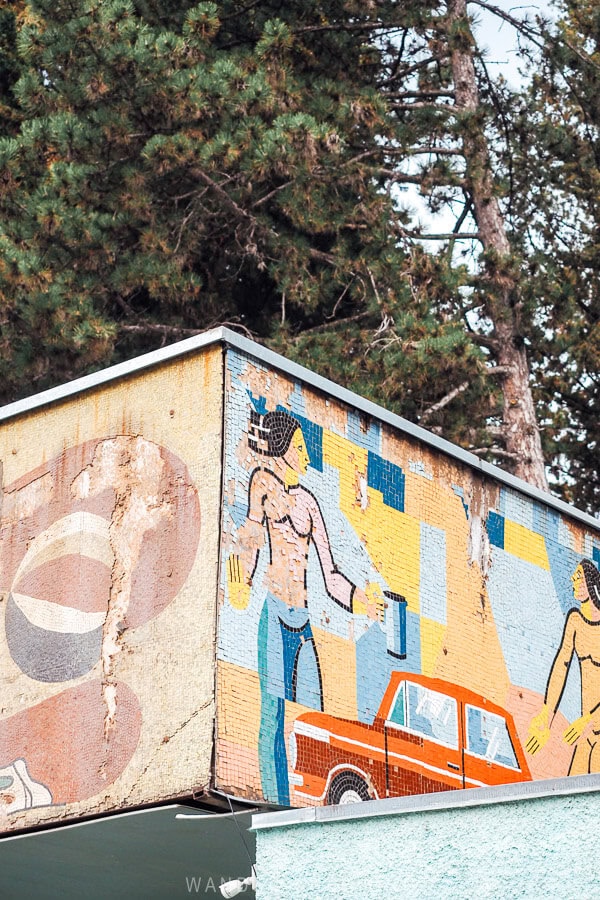
Both ends of the panel are finished with more modern, vibrant mosaics. The eastern end depicts cars and mechanical motifs, while the western end (unfortunately now completely obscured by a new building) shows a drifting cosmonaut and three comrades in CCCP helmets.
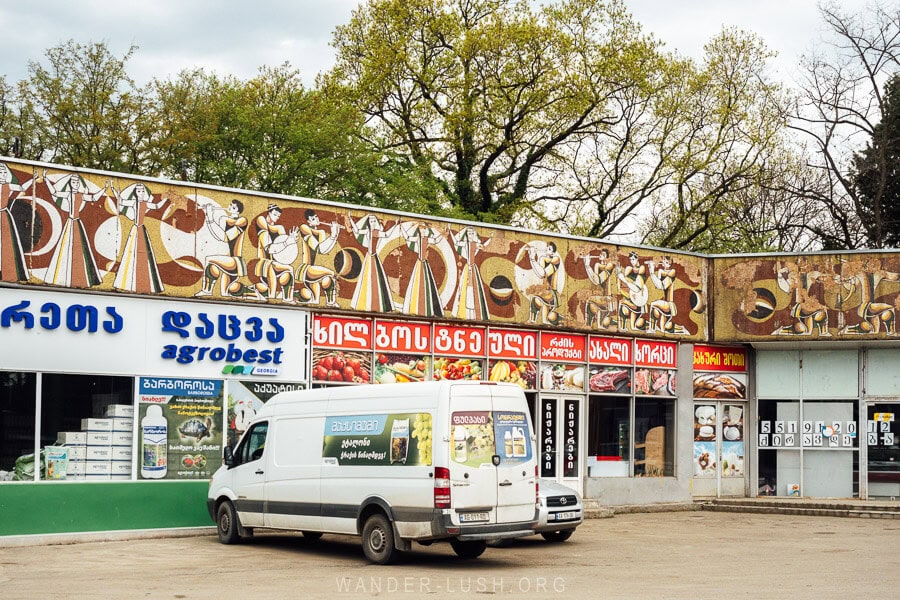
The town’s main bus depot is located on the eastern end (you will see marshrutka vans, taxis and their drivers congregated here throughout the day), while the rest of the buildings are occupied by grocery stores and other businesses.
6. See the Soldier’s Father Monument, the Memorial of Glory & Museum
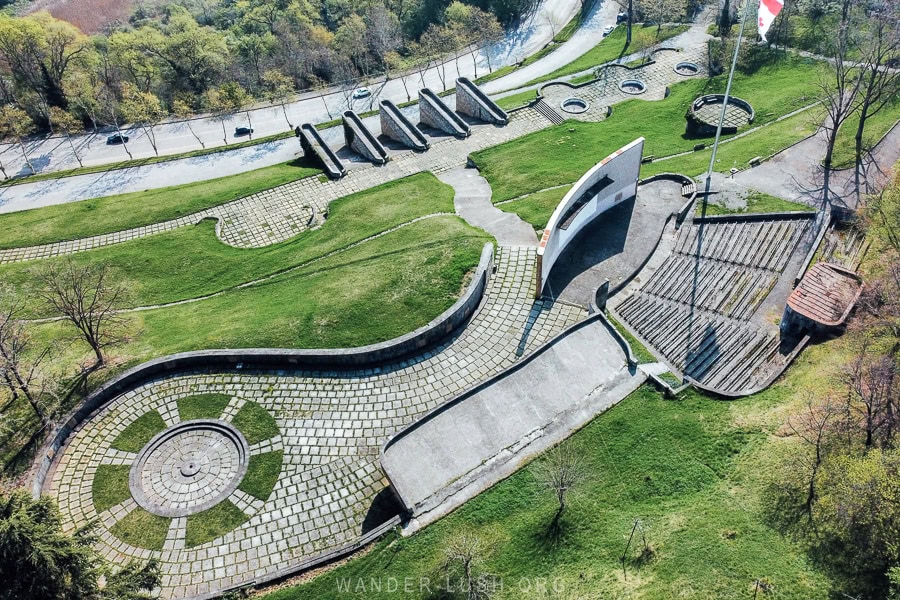
Gurjaani’s Memorial of Glory is one of the most impressive WWII monuments in Georgia. Located right on the highway as you exit the town, you can’t miss it.
The complex extends up the hillside, beginning with five stone piers modelled off Svanetian towers (created by artists Irakli Mosulishvili and Givi Japaridze). Follow the stairs to the top to find the curved Wall of Eternity, yellow tuff stone from Bolnisi carved with very-Soviet relief sculptures that depict both military imagery (soldiers marching in formation) and traditional Georgian symbols (much like those in the mosaic). Its authors are Tatiana Kakabadze and Grigol Chirinashvili.
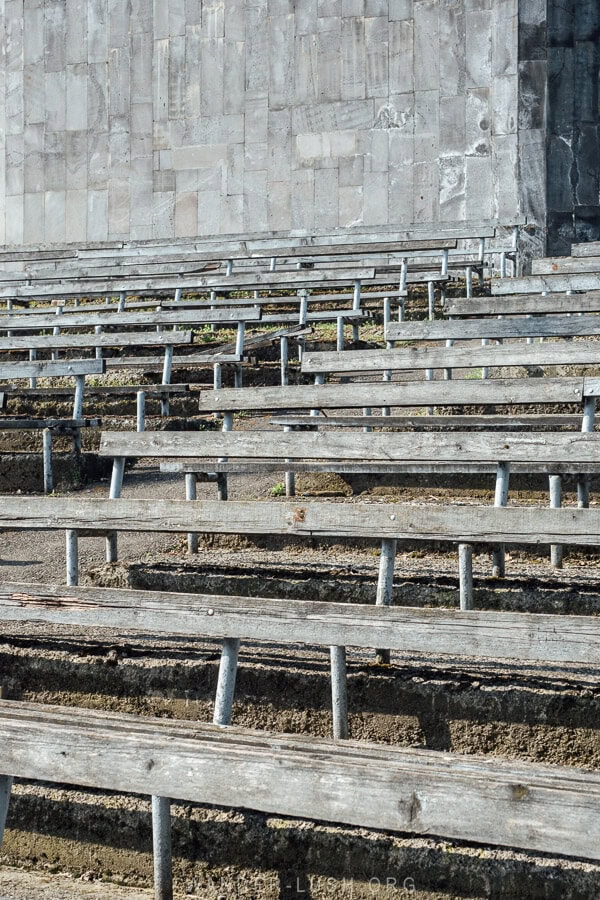
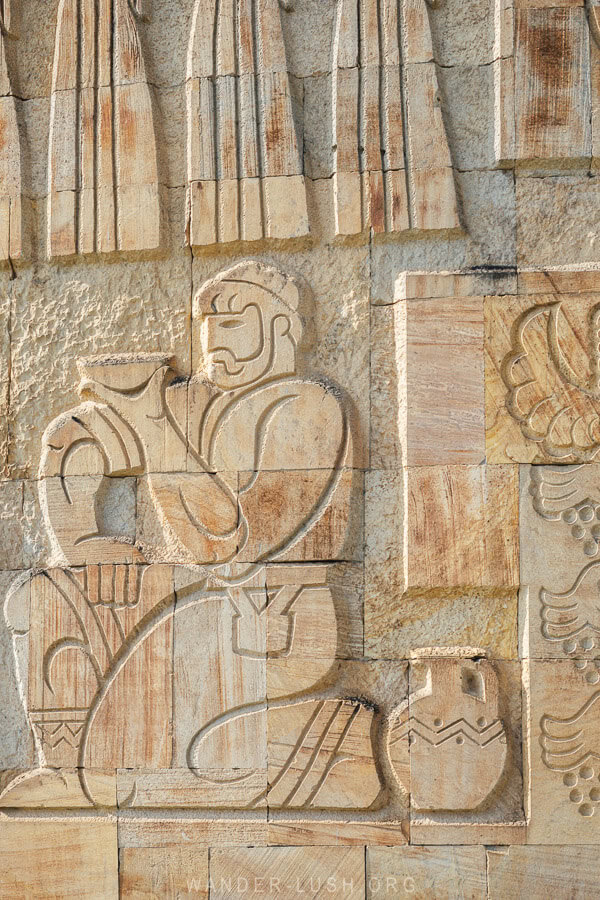
Behind the wall, there is an old amphitheatre. This opens out onto a flat terrace with an (extinguished) eternal flame, more relief panels imprinted with the names of 4,000 soldiers lost in battle, and a small glazed building that houses Gurjaani’s Glorious Memorial Museum. The nearby building with the funny dome is a former Wedding Palace that is now being refurbished.
On previous visits to Gurjaani I have always found the tiny Memorial Museum closed. I had better luck this time – for reference, it was just after 10am on a Friday morning.
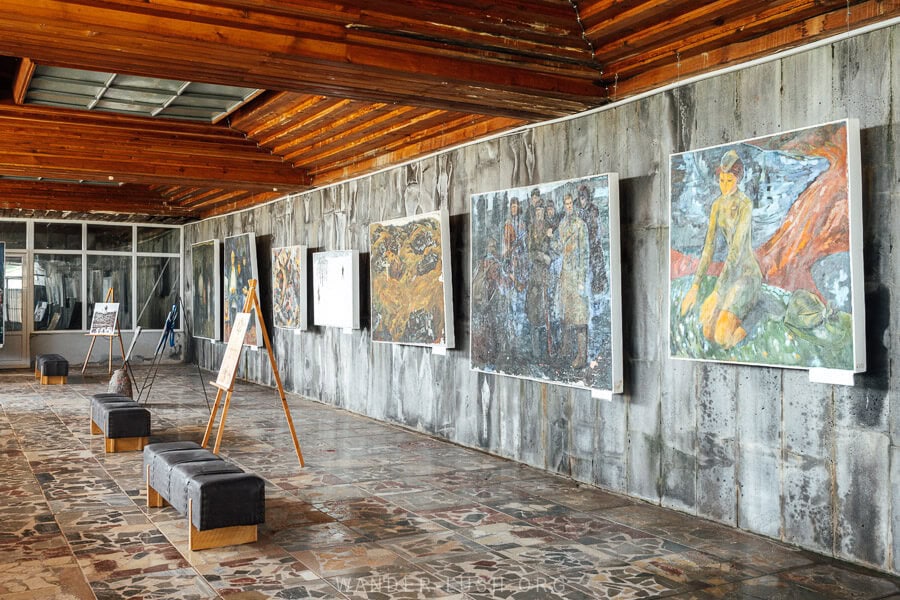
Inside the museum there is a collection of canvases that all touch on war-related themes. Easels display archival photos of the memorial’s opening day and a blown-up decree document bearing Stalin’s letterhead and signature. The original is kept behind glass in one of the display cabinets alongside medals, soldiers’ letters and other documents related to the many war heroes who hailed from Gurjaani.
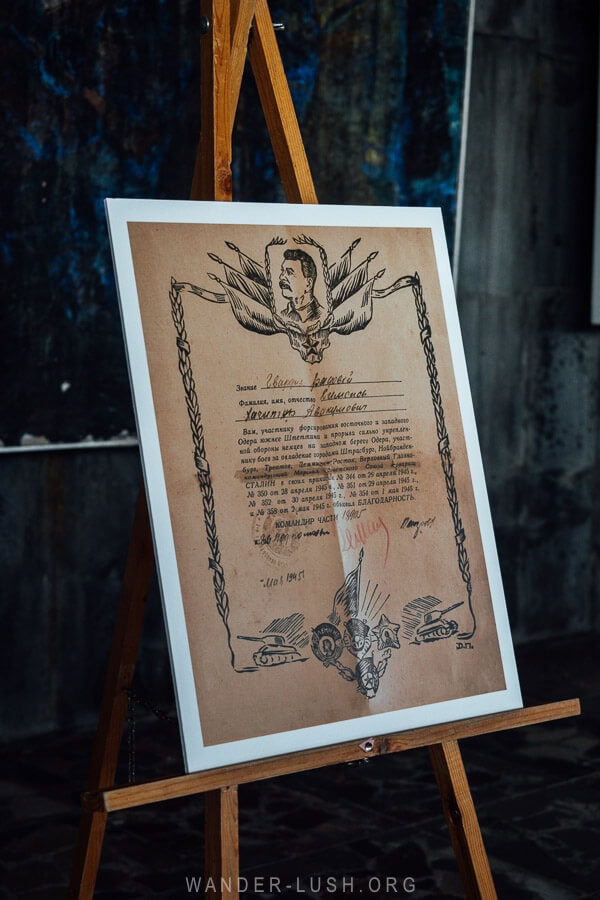
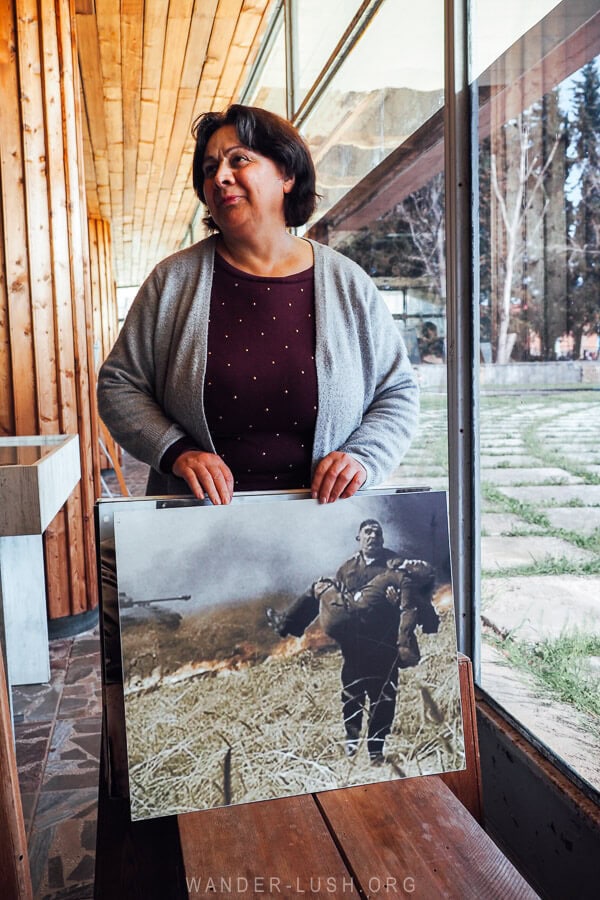
The final component of the memorial is Father of a Soldier, a 20-metre-tall, 80-ton copper sculpture by the artist Merab Berdzenishvili (below left).
The protagonist – a monolith of a man cradling a soldier’s coat and helmet in his hands – is inspired by the character Giorgi from the 1964 Soviet-Georgian war film Father of the Soldier. Directed by Revaz Chkheidze, it tells the story of a farmer who enlists to fight in WWII only to watch his son perish on the battlefield. The museum also displays still photographs from the film.
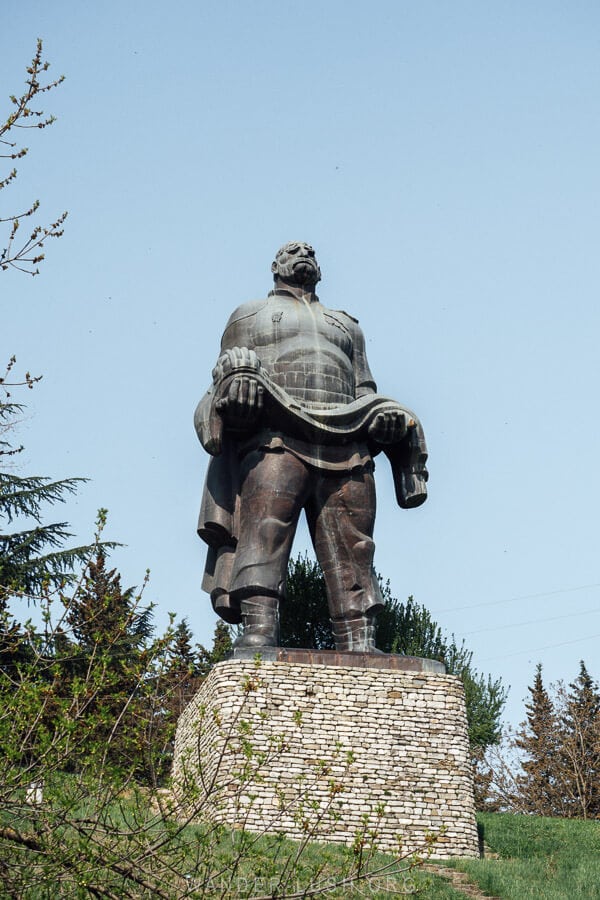
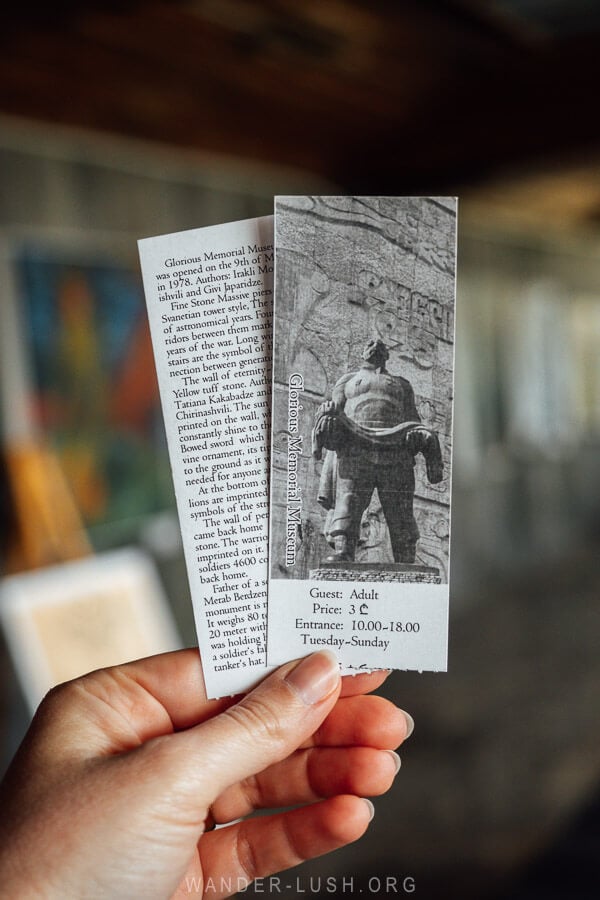
The memorial complex is open 24/7 and free to visit with the exception of the Glorious Memorial Museum, which welcomes guests from Tuesday to Sunday between 10am and 6pm, and costs 3 GEL. Manana and the other staff speak a little bit of English and will warmly welcome you.
I am told that the complex, including the amphitheatre and the museum, will be refurbished soon, so there is a chance that you might find it closed for renovation.
7. Take a mud bath at Akhtala Resort
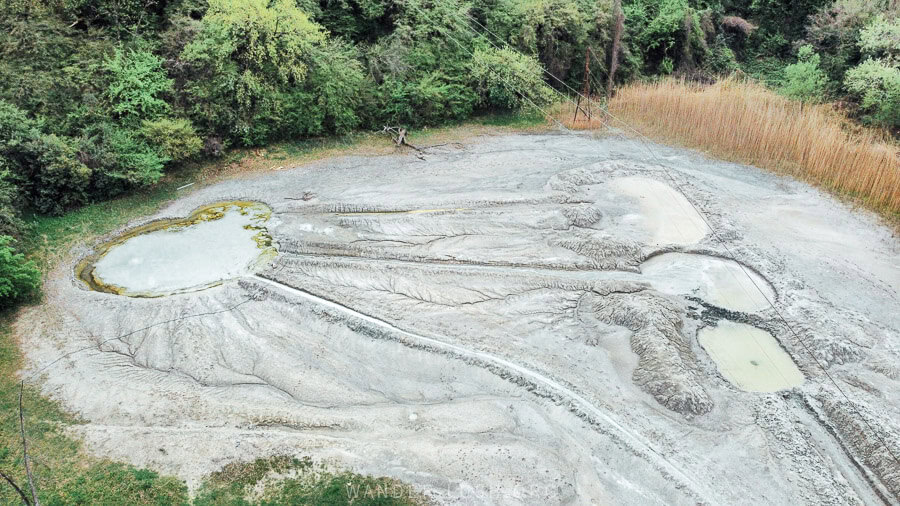
Apparently there is a dormant volcanic crater right in the centre of Gurjaani town – you can see the raised green area on the opposite hill when standing at the highest point of the memorial complex.
Warm, thick, grey mud oozes from the crater, propelled earthward by bubbling gas.
Gurjaani mud has been used since at least the 18th century, prescribed by doctors to soothe arthritic joints and relieve lymphatic conditions. In 1920, the mud baths were established as a formal balneological resort (much like the mineral water baths in Tskaltubo, Sairme and Abastumani).
Soon after, a treatment centre was built close to the mud pits and a sanatorium hotel was added nearby. A Soviet statue of a woman clasping a bunch of grapes and with a Caduceus symbol on her headdress marks the entrance.
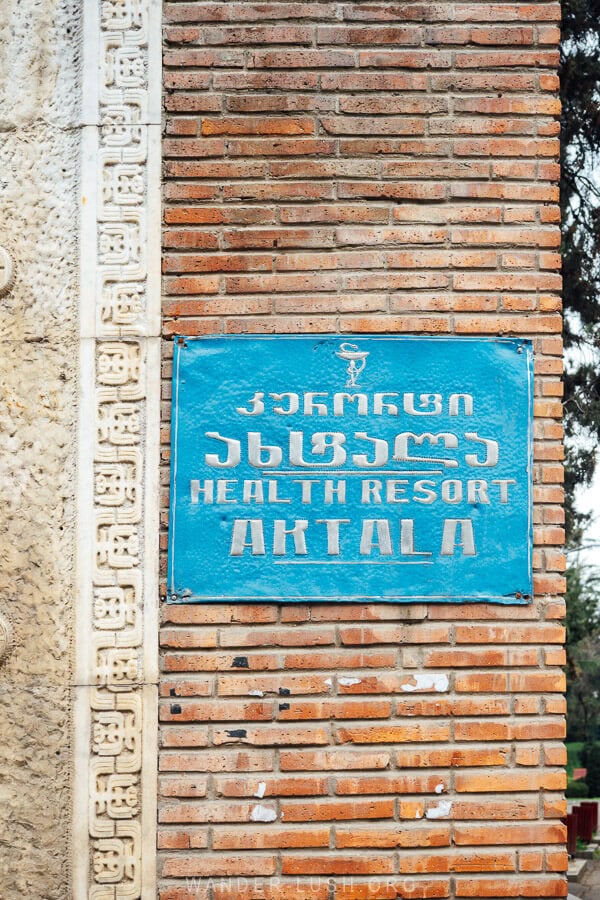
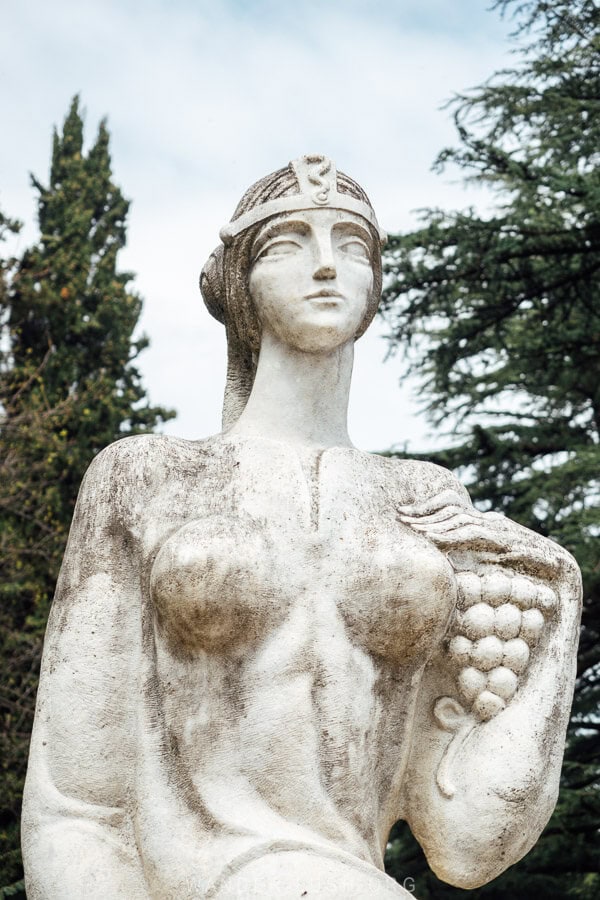
Now called Akhtala Spa, the facility is still functioning and is still very popular, I am told. I hear that certain therapists travel here all the way from Tbilisi and Batumi to syphon off precious Gurjaani mud to use at their spas.
At the time of my visit, Akhtala was undergoing major refurbishment after a change of ownership. We had a quick tour of the treatment centre – it is made up of private rooms where you can go for a mud spa. I will be back to try it at some point!
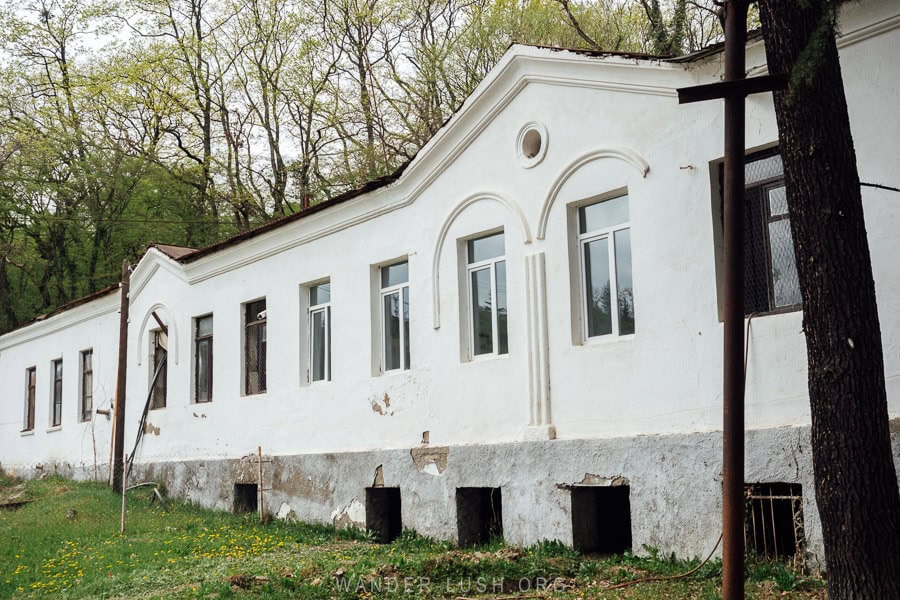
The forest park that surrounds the mud pits, Akhtala Park, is the venue for the Gurjaani Wine Festival in October. It is open to the public throughout the year. The bubbling mud pits are now enclosed in a safety fence, but you can walk around the area to see (and smell) the mud.
8. Learn about Georgian cinema at the Nato Vachnadze House Museum
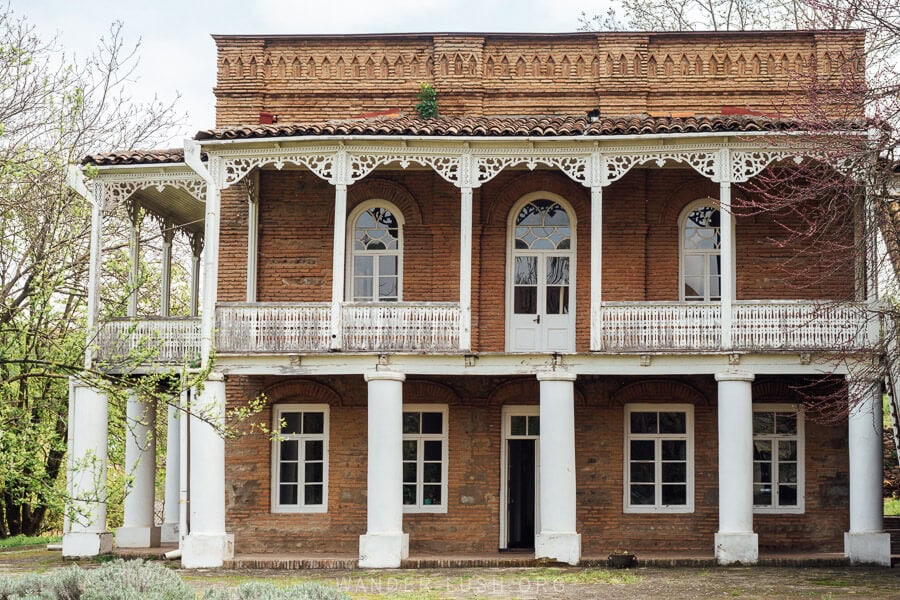
Moving beyond Gurjaani town, the Nato Vachnadze House Museum is located in Chandari, one of the oldest parts of the municipality. The houses here are just lovely, all robust red brick and elegant wooden balconies.
The former residence of Nato Vachnadze stands out among them. Born in 1904 in Warsaw, the iconic Georgian-Soviet film star lived here as a schoolgirl.
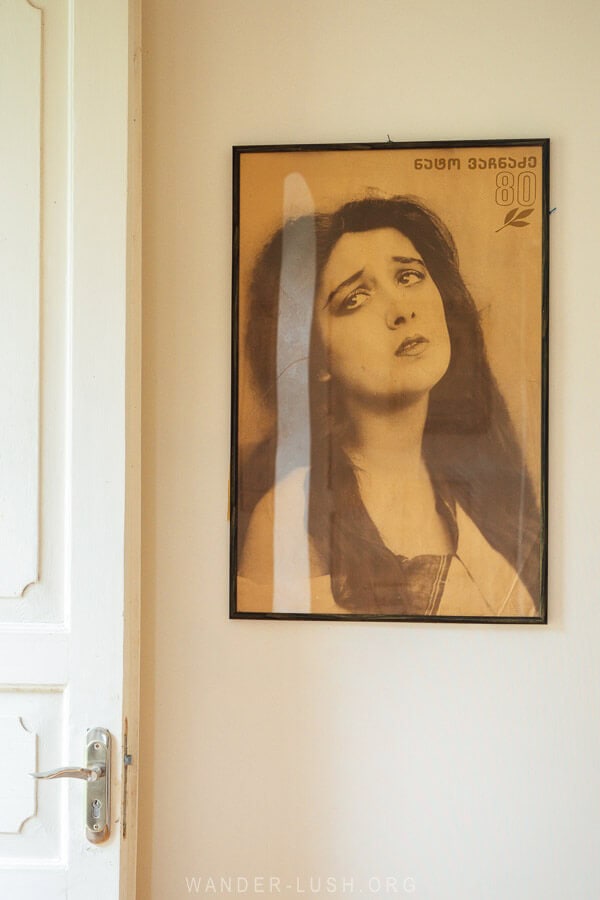
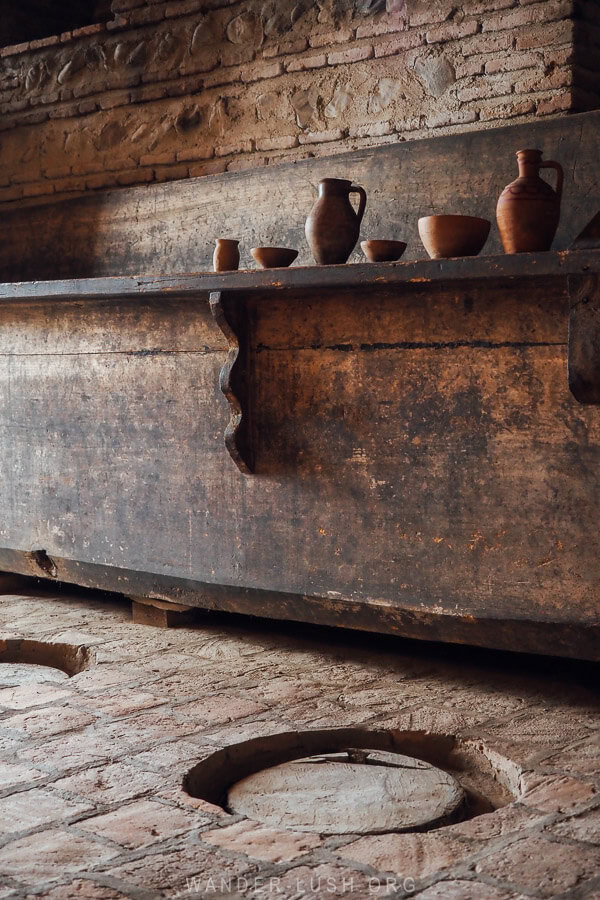
The main house has been converted into a small museum with period furniture and decorations (very similar to the Ilia Chavchavadze House Museum at Tsinandali), while a second building documents Nato’s career as an actress through photographs and retro film posters.
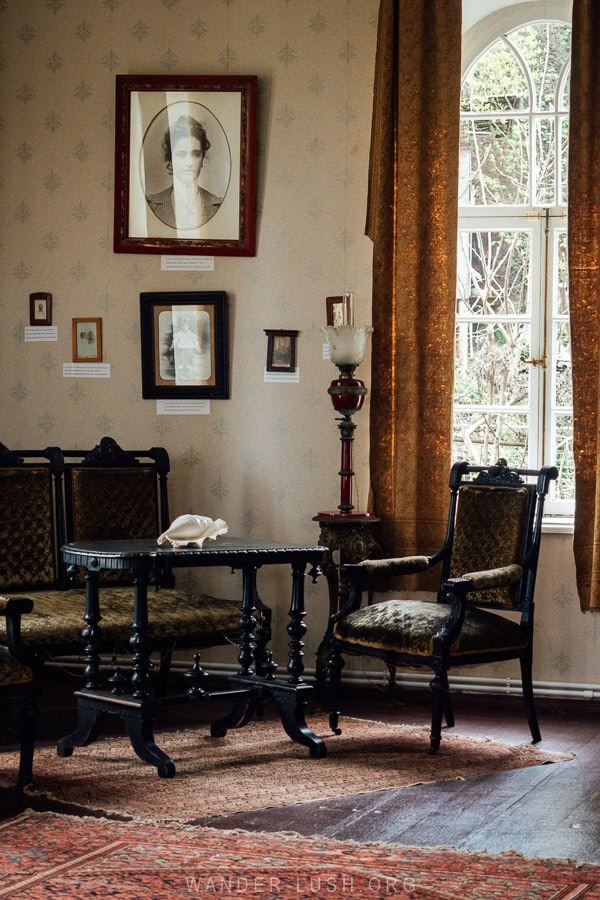
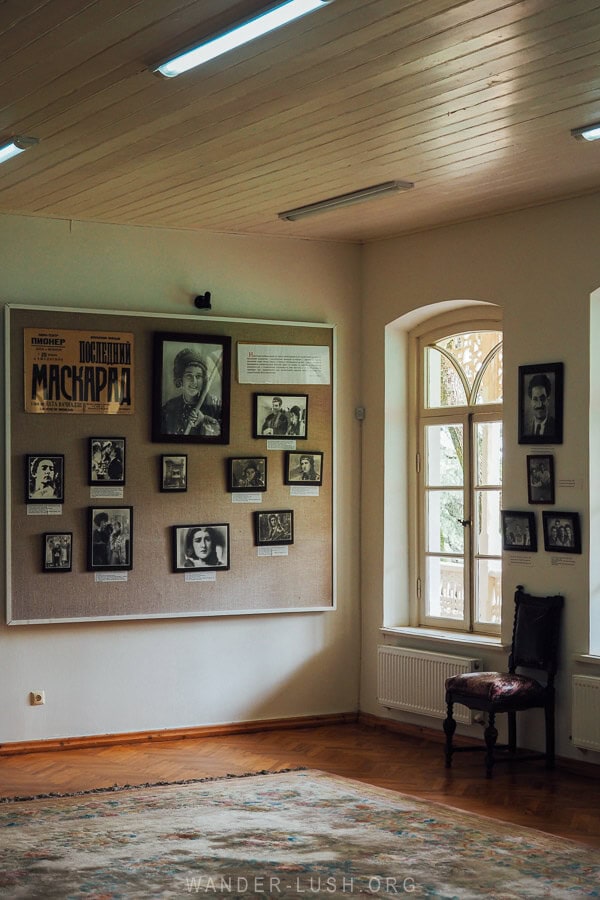
The museum is open Tuesday to Sunday from 10am until 6pm. Entrance costs a couple of GEL. The house is currently being refurbished and will host a film festival in the near future.
9. Browse the antiques at the Numisi Cellar Museum
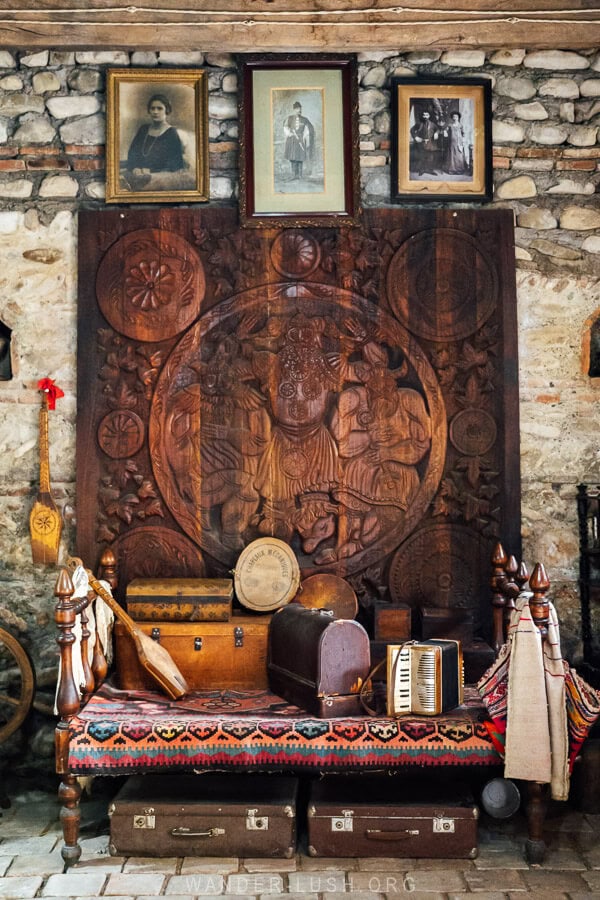
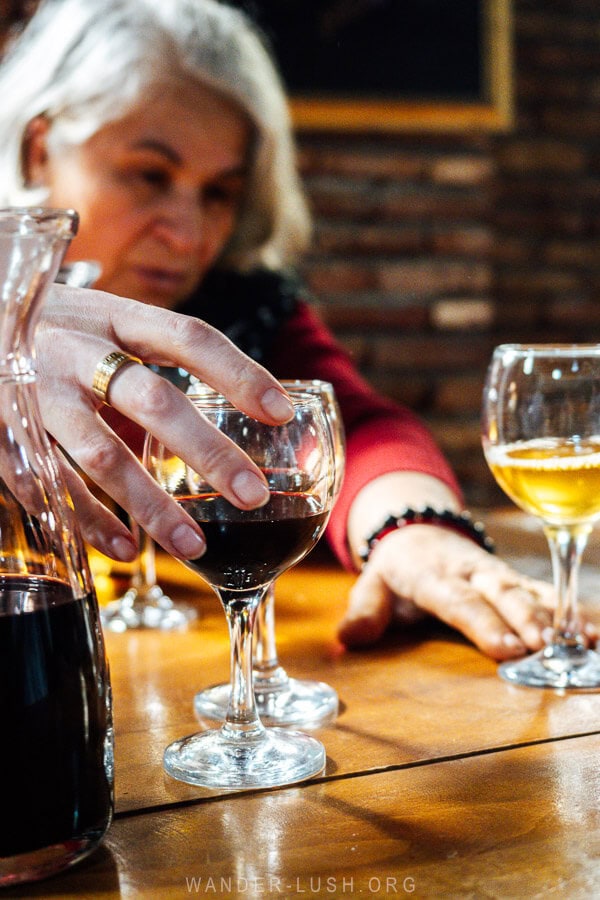
Located in another historic village, Velistsikhe, the Numisi Cellar Museum is a very popular stop for group tours. Walk-in guests are welcome to explore the grounds and try the family’s wine. Bookings are recommended.
Hostess Nunu has an incredible collection of museum-quality objects and antiques, which she has artfully arranged in her garden, underground cellar, and several rooms. The house itself, which dates to the 16th century, is quite incredible. Ask Nunu to point out the underground ice freezer!
Of all the objects in Nunu’s hoard, I was most interested in her set of Soviet-era metal signboards.
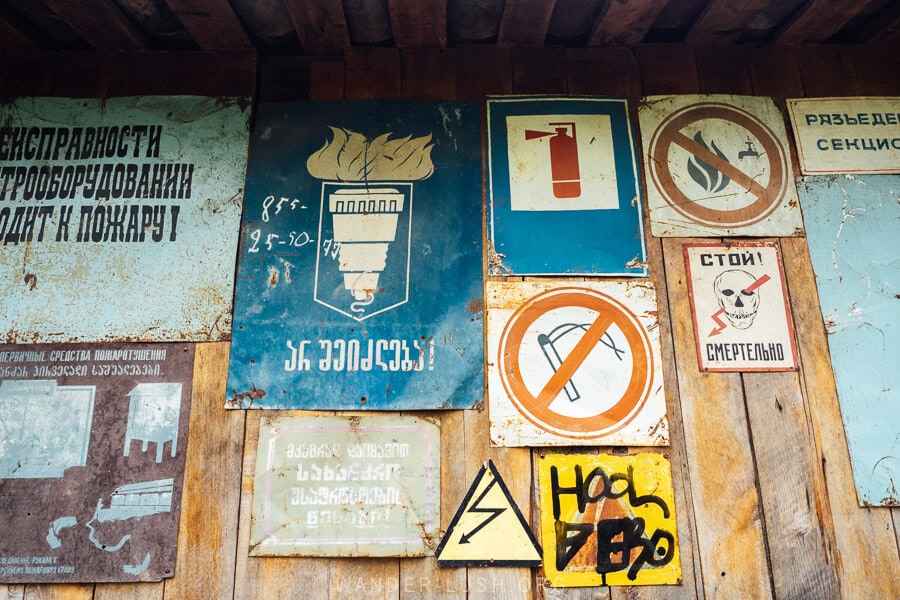
The Numisi Cellar Museum is open daily. Contact them by phone or through Facebook to organise a visit.
10. Frolic amongst the peach blossoms in Chumlaki (spring only!)
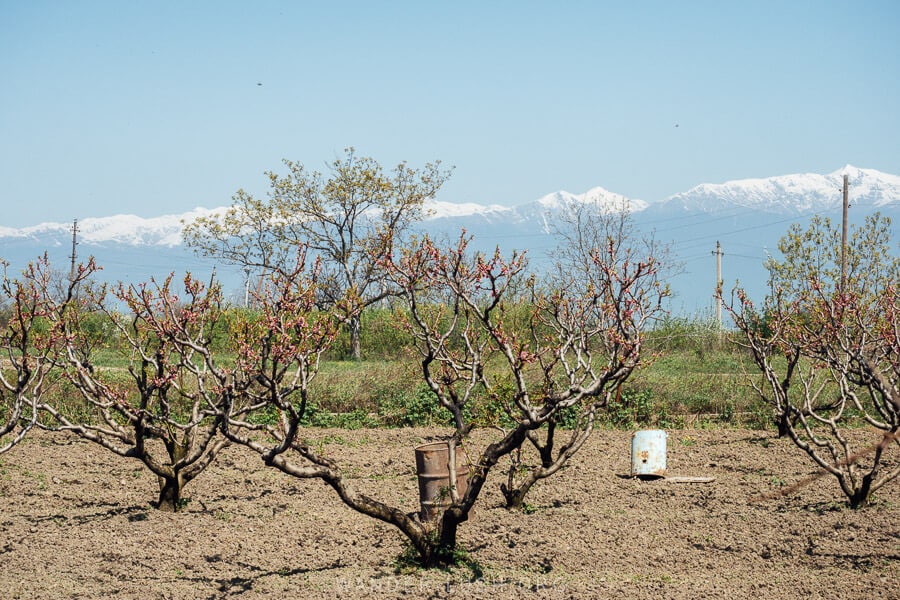
One of my major motivations for visiting Gurjaani in spring was to see the peach blossoms. This part of Kakheti is known for its fruit orchards, with gardens concentrated around the villages of Chumlaki and Yitaani.
Driving into Gurjaani, we saw hundreds of blossoming plum and cherry trees along the roadside. We got our first glimpse of the spectacular peach blossoms on the side of the new Chumlaki bypass road.
These peach orchards are privately owned, but there are several that welcome visitors in spring. We visited Agroubani. Another popular option is Mestvireni near Telavi – every spring, they host photoshoots and dinners in their peach fields (bookings essential). Otherwise you can try driving around and scouting out other locations – just be careful not to wander onto anyone’s private property by accident.
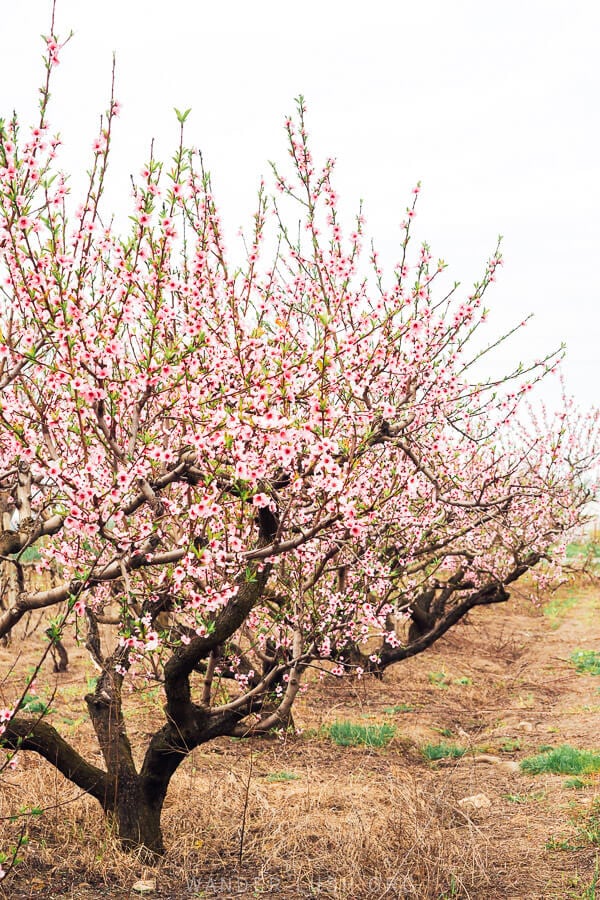
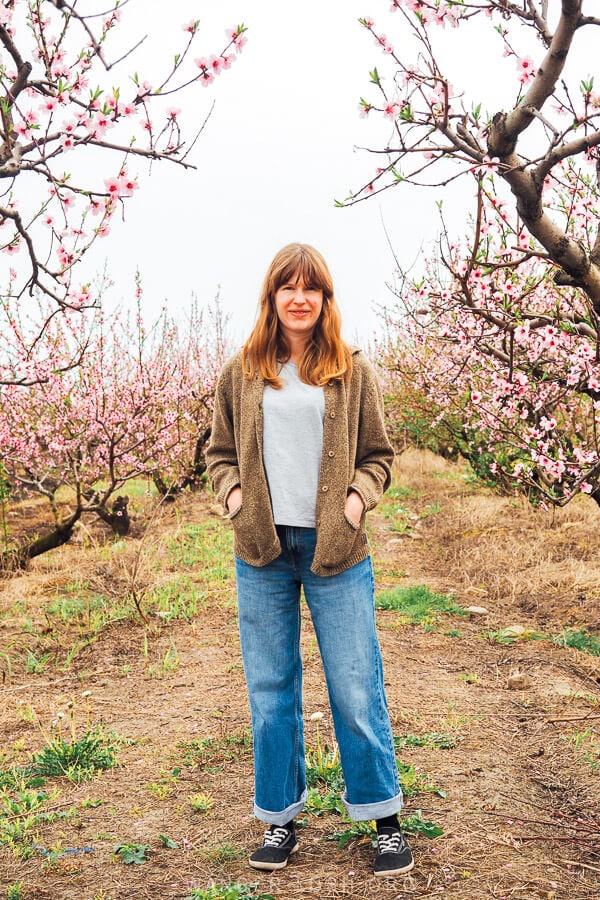
Unfortunately it was very cloudy during our visit, but when the conditions are right you can get a beautiful view of the peach blossoms against a backdrop of the snow-capped Greater Caucasus.
There is a short window of time during which to see the blooms – most years the trees start to blossom at the end of March and remain in flower until approximately April 10.
Gurjaani restaurants
With the Caucasus University Academy of Gastronomy (a collab between the Caucasus University and the Basque Culinary Center in Spain) set to open in the centre of town this year, Gurjaani is a bit of an up-and-coming foodie hotspot.
Classic Kakhetian fare is the order of the day here: Chakapuli spring stew, mtsvadi BBQ cooked on vine branches, bozbashi beef soup, and khinkali dumplings.
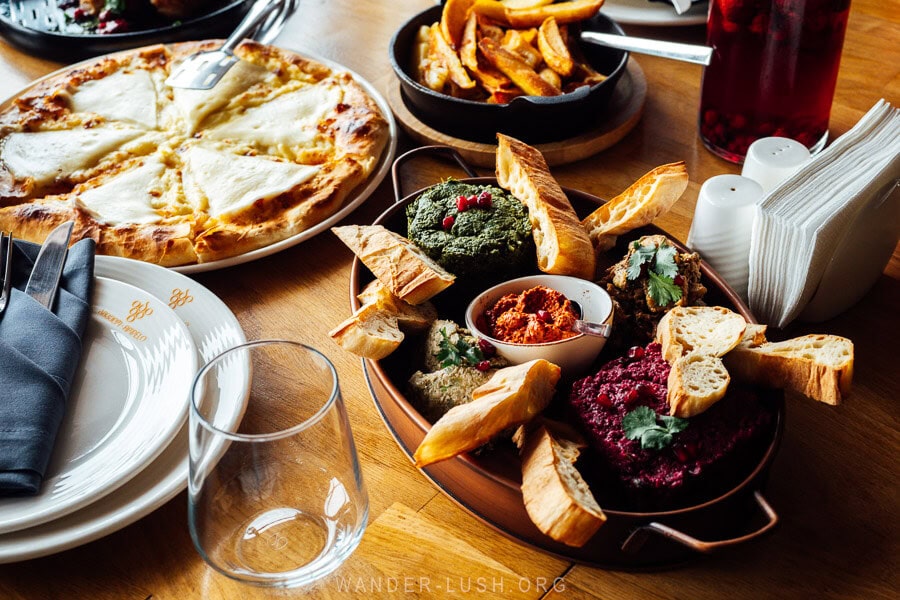
Ampelo: We had the best meal of our trip at the restaurant connected to Kardanakhi1888 cellar. Ameplo is open to walk-ins and hotel guests for lunch and dinner daily. Call ahead to make a booking.
Garden Tvisi: This wine-garden restaurant in Gurjaani town is a popular spot for groups and events. The outdoor area is the highlight.
Velistsikhe Veranda: Another popular cellar-restaurant, Velistsikhe Veranda is suitable for both a wine degustation and lunch or dinner. Unfortunately it was closed at the time of our visit, but I have heard great things about the food here from several friends. Call ahead to check that it is open and to make a booking.
Dergi: Though technically outside Gurjaani, Dergi is a short drive from Bakurtsikhe and is ideal for a meal if you’re staying at Horizons. Run by celebrity chef Levan Kobiashvili, this restaurant has a great reputation. We enjoyed the khinkali.



